BST135 2013-14 - Lectures 2 & 3 Operations Strategy - FULL
14_Lecture_Presentation

– Habitat isolation
– Behavioral isolation – Mechanical isolation
– Gametic isolation
© 2010 Pearson Education, Inc.
PREZYGOTIC BARRIERS Temporal Isolation Habitat Isolation
Sterile next-generation rice hybrid
Figure 14.5c
Mechanisms of Speciation
• A key event in the potential origin of a species occurs when a population is severed from other populations of the parent species.
• Macroevolution:
– Encompasses the major biological changes evident in the fossil record
– Includes the formation of new species
© 2010 Pearson Education, Inc.
© 2010 Pearson Education, Inc.
Allopatric speciation
Simpatric speciation
Figure 14.6
Allopatric Speciation
• Geologic processes can:
– Fragment a population into two or more isolated populations
2014年职称英语理工类ABC级讲义
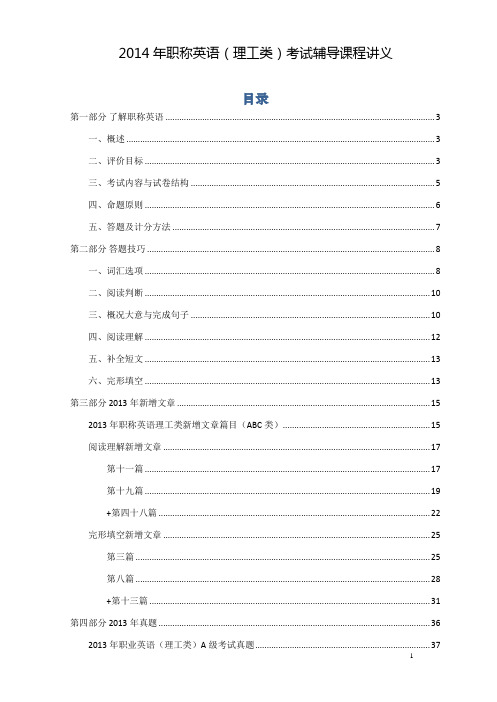
2014年职称英语(理工类)考试辅导课程讲义目录第一部分了解职称英语 (3)一、概述 (3)二、评价目标 (3)三、考试内容与试卷结构 (5)四、命题原则 (6)五、答题及计分方法 (7)第二部分答题技巧 (8)一、词汇选项 (8)二、阅读判断 (10)三、概况大意与完成句子 (10)四、阅读理解 (12)五、补全短文 (13)六、完形填空 (13)第三部分 2013年新增文章 (15)2013年职称英语理工类新增文章篇目(ABC类) (15)阅读理解新增文章 (17)第十一篇 (17)第十九篇 (19)+第四十八篇 (22)完形填空新增文章 (25)第三篇 (25)第八篇 (28)+第十三篇 (31)第四部分 2013年真题 (36)2013年职业英语(理工类)A级考试真题 (37)2013年职业英语(理工类)B级考试真题 (55)2013年职业英语(理工类)C级考试真题 (70)第一部分 了解职称英语一、概述总述:全国专业技术人员职称英语等级考试是由人事部组织实施的一项国家级外语考试。
专业类别注:三类考试的共同点和不同点:每个级别的试卷内容,除综合类外,普通英语和专业英语题目各占50%。
对于类别的区分意义不大,原则上考生报综合、理工、卫生的任何一类都是可以的,考生可结合自身情况及单位规定进行报考。
在正式考试中,50%的题都是一样的。
等级总分:100分 考试时间:120分钟注:参加考试的考生允许带一本普通的英语字典进入考场。
建议参加C 级和B 级考试的考生可以使用《牛津英汉双解词典(中级)》,参加A 级考试的考生适用《牛津英汉双解词典(高级)》,还可以同时考虑准备一本《牛津英语同义词词典》。
二、评价目标总目标:要求: (一)词汇量注:可以主要掌握2000个左右的核心单词和短语结构。
实际考试中出现的超纲词一般都会给出中文注释。
(二)语法知识注:不直接考查语法,对基本语法的考查融入到各类考题中,进行间接考查。
Lecture2_1SymbolicTech
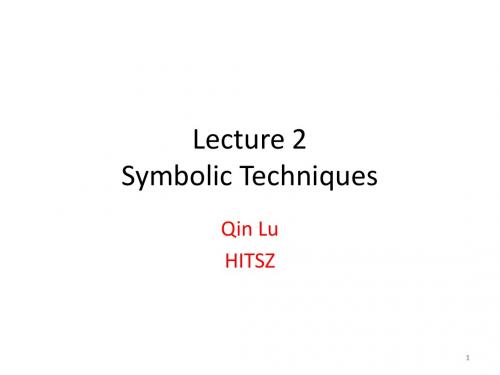
5
Lexical features
• Tokenization = converting input stream of characters into a stream of words or tokens – space-delimited languages (most European languages): • word = string of characters separated by white space – unsegmented languages (e.g., Chinese, Thai, Japanese): • e.g., use of a word list (MRD = machine-readable dictionary) • Tool: – Word Splitter /~cogcomp/atool.php?tkey=WS ( /page/tools_view/8) – Stop word list: /manuals/onix/stopwords1.html
• Porter Stemmer Tool: /~martin/PorterStemmer/
9
POS tagging and sentence parsing
• Part-of-speech (POS) or syntactical word class: – contributes to the meaning of the word in a phrase – distinct component in syntactic structure – content words: nouns, adjectives, verbs, adverbs – function words: have functional properties in syntactic structure: act as determiners, quantifiers, prepositions and connectives (e.g., articles, pronouns, particles, …)
2013年新版英语二全讲义

2013年新版英语二讲义(全)Unit 1 The Power of LanguageI. Ne w wor ds a nd ex p r es s ionsNe w wor ds1. c r itic a l a dj. 有判断力的;判断公正(或审慎)的2. no n-f ic tion n. 纪实文学3. pos iti on n. 观点;态度;立场4. s tatem ent n. 说明;说法;表态5. qu es tio n v. 表示疑问;怀疑out of ques ti on / ou t of the q ues ti on6. e va luat e v. 估计;评价;评估7. c ont ex t n. 事情发生的背景,环境,来龙去脉8. v al ue n. v al ues [p l.]是非标准;价值观va lu abl ein va lua bl e=pr ic el es sva lu eles s9. r epr es e nt v. 描述;表现r epr es enta tiv e a dj./n.10. as s er ti on n. 明确肯定;断言11. s uf f ic ient a dj. 足够的;充足的Suf f ic ienc y ins uf f ic ient12. s tat is tic n. s tat is ti c s [pl.]统计数字;统计资料13. inte gr ate v.(使)合并,成为一体14. a uth or it y n.专家;学术权威;泰斗an/th e a uthor it y o n s th.auth or i ze15. c om par e v. 比较;对比c om par e A w ith Bc om par e A t o B16. s ubj ec t n. 主题;题目;题材17. c ons is tent adj. 相符的;符合的18. inc ons is t enc y n. 不一致19. as s um ption n. 假定;假设20. c as e n. 具体情况;事例in c as ein c as e of f ir ein c as e t hat…a c as e i n po intc onf irm ed/s us pec ted c as es21. d ir ec tl y a d v. 直接地;径直地22. ide ntif y v. 找到;发现23. va lid adj. 符合逻辑的;合理的;确凿的va lid it y n. 有效性,正确(性)in val i d24. c r ed ib le a dj. 可信的;可靠的inc r ed ibl e=unb el ie vab le25. lan dm ark n.(标志重要阶段的)里程碑26. r e le van t adj. 紧密相关的;切题的r ele vanc y n. 关联;恰当ir r ele va nt27. c ur r ent adj. 现时发生的;当前的28. a ppr o pr iat e adj. 合适的;恰当的ina ppr opr iat eIt's (not) ap pr opr i ate t hat ….29. b ia s n. 偏见;偏心;偏向30. c ons ider a bl y a dv.非常;很;相当多地c ons iderc ons ider ingc ons ider a bl ec ons ider a tec ons ider a tio n31. D em oc r at n. (美国)民主党党员,民主党支持者民32. R epu bl ic an n. (美国)共和党党员,共和党支持者33. r ef lec t v. 显示;表明;表达34. inf or m ed adj. 有学问的;有见识的wel l-inf or m edil l-inf or m edPhr as es a nd Ex pr es s i ons1. ap pl y t o 使用;应用2. pu t f or th 提出;产生3. tak e … i nto ac c oun t 考虑到;顾及4. ac c ept/tak e … at f ac e v alu e 相信表面;信以为真5. wi th a gr ai n of s alt有保留地;持怀疑态度地II. T ex t Lear n ingCr itic a l R e ad ing① (1)Cr itic a l r ead ing app lies to n on-f ic tio n wr i tin g in whic h th e a uthor pu tsf or th a pos it io n or s e ek s to m ak e a s tatem ent. C r itic a l r ea di ng i s ac tiv er eadi ng. It in vo lv es m or e than j us t(不只是,不仅仅是)und er s tand ing what an a uthor is s a yi n g. Cr itic a l r ea din g in vol v es ques t ion ing an d e v alu ati ng what t he auth or is s a yi n g, and f or m ing yo u r own o pi nio ns ab out w hat t he auth or is s a yi ng. H er e ar e the t hi ngs yo u s hou ld do t o be a c r itic al r ea der.(启下句)本部分重点及难点:1. Cr it ic al r ead ing ap pli es to non-f ic tio n wr iti ng in whic h t he aut hor putsf or th a pos it io n or s e ek s to m ak e a s tatem ent.app l y to s b./s th.= b e ap pl ic abl e to s b./s t h.app l y的派生词:a p plic a tio n, a pp lic a nt, a ppl ic ab le② C ons ider t he c o nte x t of wh at is wr itte n. You m a y b e r ea di ng s om ething that w as wr itt en b y a n aut hor f r om a diff er ent c u ltur a l c ont ex t th an your s.(2)O r, you m a y b e r e adi ng s om ethin g wr it t en s om e tim e ago in a dif f er ent tim e c ontex t tha n yo ur s. (3)In eit her c as e, you m us t r ec ogn i ze an d tak e into ac c ount a n y dif f er enc es bet ween yo ur v al u es and att itud es an d t hos er epr es ente d b y t he a u thor.本部分重点及难点:2. O r, yo u m a y be r ea din g s om ething wr itt e n s om e tim e ago in a dif f er ent tim e c ontex t tha n yo u r s.s om e tim e注意区分:s om etim e / s om etim es / s om e tim es3. I n eit her c as e, you m us t r ec ogn i ze and ta k e into ac c ount a n y d i ff er enc es bet we en yo ur v al ues and att itud es an d t hos e r epr es e nted b y t he auth or. 不论哪种情况,你必须注意并考虑你的价值观和态度与作者所述的价值观和态度有何不同。
SAE USCAR-2-2013第6版中文

汽车电连接器系统性能规范SAE/USCAR-2第6版2013.2ISBN:978-0-7680-7998-2SAE/USCAR-2第6版颁布日期1997年8月修订日期2013年2月汽车电连接器系统的性能规范目录1.范围 (3)2.试验顺序 (3)3.参考文档 (3)3.1文件的层次 (3)3.2零件图 (4)3.3产品设计规范 (4)3.4测试要求/指令 (4)3.4.1样品,测试类型,和特殊测试 (4)3.4.2测试要求/指令说明 (4)3.4.3性能和耐久性测试说明 (4)3.5本规范中所提到的文档 (4)4.一般要求 (5)4.1纪录保存 (5)4.2样品文件 (5)4.3样品数量 (5)4.4默认测试公差 (5)4.5设备 (6)4.6测量精确度 (6)4.7测试重复性&校准 (6)4.8一致性测定 (7)4.9样品的处置 (7)4.10零件的耐久性 (7)5.测试和验收要求 (7)5.1总则 (7)5.1.1性能要求 (7)5.1.2尺寸特性 (7)5.1.3材料特性 (7)5.1.4分类等级 (8)5.1.5试验端板&直接连接组件 (9)5.1.6端子样品准备 (10)5.1.7连接器和/或端子循环 (10)5.1.8外观检验 (11)5.1.9电路连续性监测 (12)5.1.10多腔(垫)导体密封样品准备 (14)The research data,analysis,conclusion,opinions and other contents of this document are solely the product of the authors.Neither the SAE International(SAE)nor the United States Council for Automotive Research(USCAR)certifies the compliance of any products with the requirements of nor makes any representations as to the accuracy of the contents of this document nor to its applicability for purpose.It is the sole responsibility of the user of this document to determine whether or not it is applicable for their purposes.Copyright©2013USCAR Printed in U.S.A. All rights reserved.QUESTIONS REGARDING THIS DOCUMENT:(248)273-2470FAX(248)273-2494TO PLACE A DOCUMENT ORDER:(724)776-4970FAX(724)776-07905.2端子机械测试 (14)5.2.1端子到端子的啮合/分离力 (14)5.2.2端子抗弯性 (15)5.3端子-电器性能试验 (17)5.3.1干电路电阻 (17)5.3.2电压降 (19)5.3.3最大试验电流能力 (21)5.3.4电流循环 (24)5.4连接器-机械性能试验 (25)5.4.1端子至连接器插入/保持和前止力 (25)5.4.2连接器至连接器插入/拔出/保持/锁扭转力(非辅助) (29)5.4.3连接器到连接器的插拔力(机械辅助) (31)5.4.4极性特征有效性 (34)5.4.5混合组件的啮合分离力 (35)5.4.6振动/机械冲击 (37)5.4.7连接器到连接器可听见的咔哒响 (44)5.4.8连接器跌落测试 (44)5.4.9模腔损坏系数 (45)5.4.10端子/型腔极性测试 (46)5.4.11连接器安装特征机械强度 (47)5.4.12机械辅助完整性–(仅有机械辅助的连接器) (49)5.4.13连接器密封保持-未插合的连接器 (50)5.4.14连接器密封保持-插合的连接器 (52)5.5连接器-电气性能测试 (52)5.5.1绝缘电阻 (52)5.6连接器环境测试 (53)5.6.1热冲击 (53)5.6.2温湿度循环 (54)5.6.3高温暴露 (55)5.6.4耐流体性能 (56)5.6.5浸泡 (57)5.6.6压力/真空泄露 (58)5.6.7高压喷射 (60)5.7端板测试 (61)5.7.1端板插针保持力 (61)5.8剧烈任务试验 (63)5.9测试顺序 (63)5.9.1一般说明 (63)5.9.2测试流程图 (63)5.9.3端子机械性能测试顺序 (64)5.9.4端子电气性能测试顺序 (64)5.9.5连接器系统机械性能测试顺序 (64)5.9.6连接器系统电气性能测试顺序 (65)5.9.7密封性连接器系统环境性能测试顺序 (66)5.9.8非密封性连接器系统环境性能测试顺序 (67)5.9.9独立密封性能测试顺序 (67)6.附录 (68)6.1附录A:术语 (68)6.2附录B:缩略语 (70)6.3附录C:对于新的或移动工具和材料变更的测试 (72)6.4附录D:对于新的/现有的端子或连接器设计的测试 (73)6.5附录E:来源列表 (74)6.6附录F:设计说明:温度和额定电流 (75)6.7附录G:修订 (76)1.范围本规范中包含的程序旨在涵盖在低电压(0-20VD C)道路车辆应用中组成电气连接系统的电气终端、连接器和部件的开发、生产和现场分析的所有阶段的性能测试。
翻译
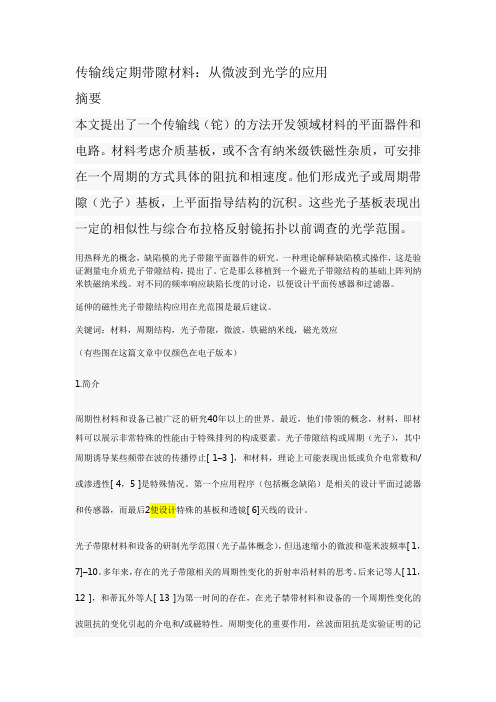
传输线定期带隙材料:从微波到光学的应用摘要本文提出了一个传输线(铊)的方法开发领域材料的平面器件和电路。
材料考虑介质基板,或不含有纳米级铁磁性杂质,可安排在一个周期的方式具体的阻抗和相速度。
他们形成光子或周期带隙(光子)基板,上平面指导结构的沉积。
这些光子基板表现出一定的相似性与综合布拉格反射镜拓扑以前调查的光学范围。
用热释光的概念,缺陷模的光子带隙平面器件的研究。
一种理论解释缺陷模式操作,这是验证测量电介质光子带隙结构,提出了。
它是那么移植到一个磁光子带隙结构的基础上阵列纳米铁磁纳米线。
对不同的频率响应缺陷长度的讨论,以便设计平面传感器和过滤器。
延伸的磁性光子带隙结构应用在光范围是最后建议。
关键词:材料,周期结构,光子带隙,微波,铁磁纳米线,磁光效应(有些图在这篇文章中仅颜色在电子版本)1.简介周期性材料和设备已被广泛的研究40年以上的世界。
最近,他们带领的概念,材料,即材料可以展示非常特殊的性能由于特殊排列的构成要素。
光子带隙结构或周期(光子),其中周期诱导某些频带在波的传播停止[ 1–3 ],和材料,理论上可能表现出低或负介电常数和/或渗透性[ 4,5 ]是特殊情况。
第一个应用程序(包括概念缺陷)是相关的设计平面过滤器和传感器,而最后2使设计特殊的基板和透镜[ 6]天线的设计。
光子带隙材料和设备的研制光学范围(光子晶体概念),但迅速缩小的微波和毫米波频率[ 1,7]–10。
多年来,存在的光子带隙相关的周期性变化的折射率沿材料的思考。
后来记等人[ 11,12 ],和蒂瓦外等人[ 13 ]为第一时间的存在,在光子禁带材料和设备的一个周期性变化的波阻抗的变化引起的介电和/或磁特性。
周期变化的重要作用,丝波面阻抗是实验证明的记等人[ 12],andsaib等人[ 14]。
严格来说,这些实验证明是根据变化的导模特性阻抗,因为平面微带传输线躺在该基板用于实验。
在本文中我们将考虑应用相结合影响:光子/定期带隙结构(光子),如上述定义,和铁磁材料的表现低或负磁导率[ 4,15 ]。
上海理工大学校定B类及以上期刊库201312版
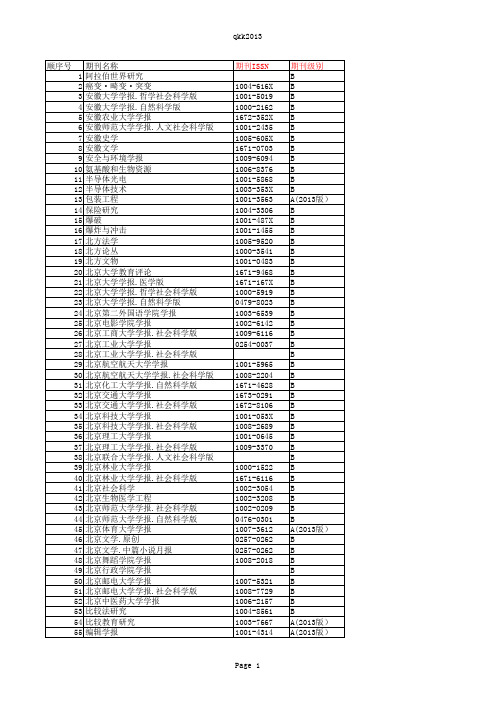
期刊名称 阿拉伯世界研究 癌变·畸变·突变 安徽大学学报.哲学社会科学版 安徽大学学报.自然科学版 安徽农业大学学报 安徽师范大学学报.人文社会科学版 安徽史学 安徽文学 安全与环境学报 氨基酸和生物资源 半导体光电 半导体技术 包装工程 保险研究 爆破 爆炸与冲击 北方法学 北方论丛 北方文物 北京大学教育评论 北京大学学报.医学版 北京大学学报.哲学社会科学版 北京大学学报.自然科学版 北京第二外国语学院学报 北京电影学院学报 北京工商大学学报.社会科学版 北京工业大学学报 北京工业大学学报.社会科学版 北京航空航天大学学报 北京航空航天大学学报.社会科学版 北京化工大学学报.自然科学版 北京交通大学学报 北京交通大学学报.社会科学版 北京科技大学学报 北京科技大学学报.社会科学版 北京理工大学学报 北京理工大学学报.社会科学版 北京联合大学学报.人文社会科学版 北京林业大学学报 北京林业大学学报.社会科学版 北京社会科学 北京生物医学工程 北京师范大学学报.社会科学版 北京师范大学学报.自然科学版 北京体育大学学报 北京文学.原创 北京文学.中篇小说月报 北京舞蹈学院学报 北京行政学院学报 北京邮电大学学报 北京邮电大学学报.社会科学版 北京中医药大学学报 比较法研究 比较教育研究
B B A(2013版) A(2013版) B B B B B B B B B B B B B B B B B B B A(2013版) B A(2013版) B B B B B B B B B B B B A(2013版) B B B B B B B A(2013版) B B B B B A(2013版) B B
qkk2013
顺序号 1 2 3 4 5 6 7 8 9 10 11 12 13 14 15 16 17 18 19 20 21 22 23 24 25 26 27 28 29 30 31 32 33 34 35 36 37 38 39 40 41 42 43 44 45 46 47 48 49 50 51 52 53 54
2013年泛珠三角及中华名校物理奥林匹克邀请赛试题及答案
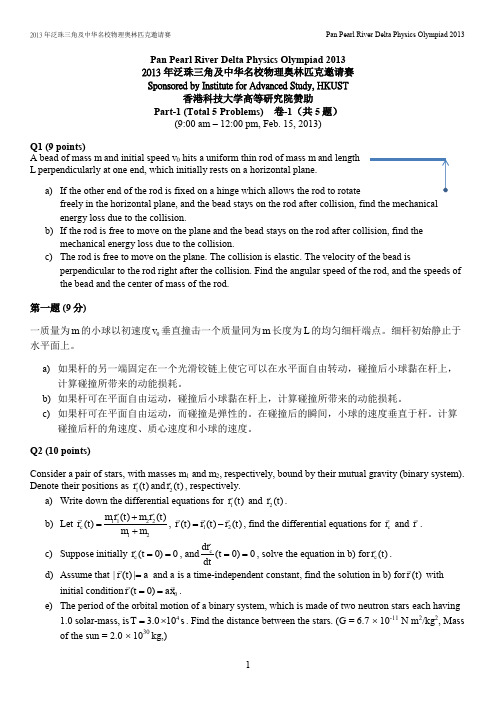
Pan Pearl River Delta Physics Olympiad 20132013年泛珠三角及中华名校物理奥林匹克邀请赛Sponsored by Institute for Advanced Study, HKUST香港科技大学高等研究院赞助Part-1 (Total 5 Problems) 卷-1(共5题)(9:00 am – 12:00 pm, Feb. 15, 2013)Q1 (9 points)A bead of mass m and initial speed v 0 hits a uniform thin rod of mass m and lengthL perpendicularly at one end, which initially rests on a horizontal plane.a) If the other end of the rod is fixed on a hinge which allows the rod to rotatefreely in the horizontal plane, and the bead stays on the rod after collision, find the mechanicalenergy loss due to the collision.b) If the rod is free to move on the plane and the bead stays on the rod after collision, find themechanical energy loss due to the collision.c) The rod is free to move on the plane. The collision is elastic. The velocity of the bead isperpendicular to the rod right after the collision. Find the angular speed of the rod, and the speeds ofthe bead and the center of mass of the rod.第一题 (9分)一质量为m 的小球以初速度0v 垂直撞击一个质量同为m 长度为L 的均匀细杆端点。
放射性物质空运教程
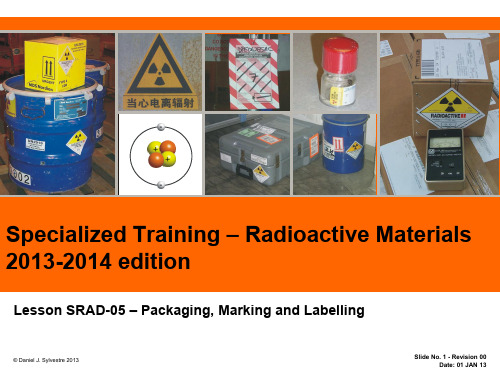
Slide No. 4 - Revision 00 Date: 01 JAN 13
Specialized Training – Radioactive Materials - 2013-2014 edition
Lesson SRAD-05 – Packaging, Marking and Labelling
• Packages built to these performance standards can be constructed in many different shapes and sizes. • The activity limits determine the type of package to be used. • The quantity of radioactive material in a package must not exceed the relevant limits for the package type as specified.
• Excepted Packages must be marked and labeled with: • UN number, preceded by the letters “UN”; • Note that there is no requirement for a proper shipping name ! • Full name and address of the shipper and consignee; and • Permissible gross weight, if this exceeds 50 kg. • “Radioactive Material — Excepted Package” handling label.
2013~2014学年度高二第二学期期中考试物理试题

2013~2014学年度第二学期高二期中考试物理(理)试卷考试时间:90分钟 满分:100分 命题人:李春生一. 单项选择题(每题3分,合计36分)1. 电阻为1 Ω的矩形线圈绕垂直于磁场方向的轴,在匀强磁场中匀速转动,产生的交变电动势随时间变化的图象如图所示.现把交流电加在电阻为9 Ω的电热丝上,下列判断正确的是( )A.线圈转动的角速度ω=100 rad/sB.在t =0.01 s 时刻,穿过线圈的磁通量最大C.电热丝两端的电压U =100 2 VD.电热丝此时的发热功率P =1 800 W2. 水平放置的两条光滑轨道上有可自由移动的金属棒PQ 、MN ,MN 的左边有一闭合电路,当PQ 在外力的作用下运动时,MN 向右运动.则PQ 所做的运动可能是( )A.向左减速运动B.向左加速运动C.向右匀速运动D.向右加速运动3. 足够长的U 型光滑金属导轨平面与水平面成θ角(0<θ<90°),其中MN 与PQ平行且间距为L ,导轨平面与磁感应强度为B 的匀强磁场垂直,导轨电阻不计.金属棒ab 由静止开始沿导轨下滑,并与两导轨始终保持垂直且良好接触,ab 棒接入电路的电阻为R ,当流过ab 棒某一横截面的电量为q 时,棒的速度大小为v ,则金属棒ab 在这一过程中( ).A .运动的平均速度大小为12vB .下滑的位移大小为qR BLC .产生的焦耳热为qBLvD .受到的最大安培力大小为B 2L 2v Rsin θ 4. 如图所示,一只理想变压器的副线圈上通过输电线接有两个相同的灯泡L 1和L 2,输电线等效电阻为R .开始时开关S 断开,当S 接通时,下列选项不正确的是( )A.副线圈两端M 、N 的输出电压减小B.副线圈输电线等效电阻R 上的电压降增大C.通过灯泡L 1的电流减小D.原线圈中的电流增大5. 空间存在两个磁场,磁感应强度大小均为B ,方向相反且垂直纸面,MN 、PQ 为其边界,OO ′为其对称轴.一导线折成边长为l 的正方形闭合回路abcd ,回路在纸面内以恒定速度v0向右运动,当运动到关于OO ′对称的位置是( ).A .穿过回路的磁通量为零B .回路中感应电动势大小为2Blv 0C .回路中感应电流的方向为顺时针方向D .回路中ab 边与cd 边所受安培力方向相同6. 如图所示的电路中,三个相同的灯泡a 、b 、c 和电感L 1、L 2与直流电源连接,电感的电阻忽略不计.电键K 从闭合状态突然断开时,下列判断正确的有( )A.a 先变亮,然后逐渐变暗B.b 先变亮,然后逐渐变暗C.c 先变亮,然后逐渐变暗D.b 、c 都逐渐变暗7. 如图所示,一导线弯成闭合线圈,以速度v 向左匀速进入磁感应强度为B 的匀强磁场,磁场方向垂直平面向外.线圈总电阻为R ,从线圈进入磁场开始到完全进入磁场为止,下列结论正确的是( ).A.感应电流一直沿顺时针方向B.线圈受到的安培力先增大,后减小C.感应电动势的最大值E =BrvD.穿过线圈某个横截面的电荷量为B (r 2+πr 2)R8.如图所示为一交变电流的i-t 图象,下列说法正确的是( )A.交变电流的频率f =50 Hz ,有效值为5 5 AB.交变电流的有效值I =5 2 AC.交变电流的平均值I =10 AD.若此交变电流通过阻值为10 Ω的电阻,则这个电阻两端的电压为2510 V9. 如图所示为一光滑轨道,其中MN 部分为一段对称的圆弧,两侧的直导轨与圆弧相切,在MN 部分有如图所示的匀强磁场,有一较小的金属环如图放置在P 点,金属环由静止自由释放,经很多次来回运动后,下列判断正确的有( ).A.金属环仍能上升到与P 等高处B.金属环最终将静止在最低点C.金属环上升的最大高度与MN 等高D.金属环上升的最大高度一直在变小10. 轻质细绳长为L,一端系一质量为的M 木块,另一端悬于o 点.今有一质量为m 的子弹以水平速度v 射入木块,一起绕o 点在竖直平面内刚好作圆周运动,则子弹的射入速度v 等于:( )A . m )gL/m 5(M +B . m )gL/m 4(M +C .(M+m)gL 5/mD .2(M+m)gL /m11. 理想变压器初级和次级线圈的匝数分别为n 1=10匝和n 2=100匝,次级线圈接有1000Ω的电阻,初级线圈与电阻不计的导线构成闭合回路,其中圆形区域的面积为24.0m s π=。
广东省执信中学2013-2014学年高二下学期期中英语试题 Word版含答案
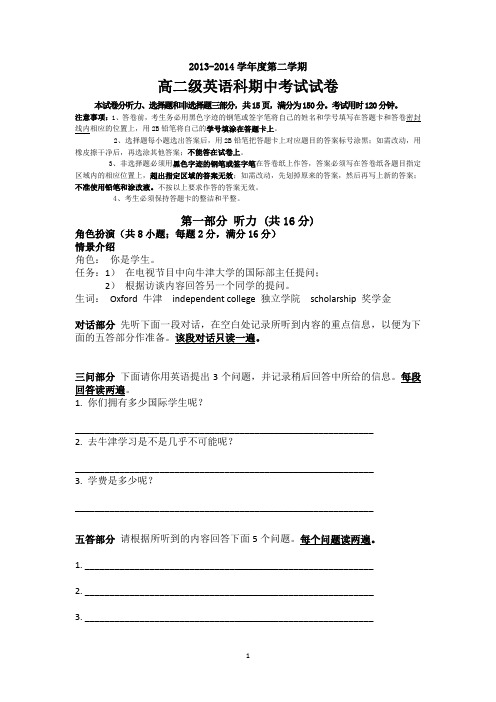
2013-2014学年度第二学期高二级英语科期中考试试卷本试卷分听力、选择题和非选择题三部分,共15页,满分为150分。
考试用时120分钟。
注意事项:1、答卷前,考生务必用黑色字迹的钢笔或签字笔将自己的姓名和学号填写在答题卡和答卷密封线内相应的位置上,用2B铅笔将自己的学号填涂在答题卡上。
2、选择题每小题选出答案后,用2B铅笔把答题卡上对应题目的答案标号涂黑;如需改动,用橡皮擦干净后,再选涂其他答案;不能答在试卷上。
3、非选择题必须用黑色字迹的钢笔或签字笔在答卷纸上作答,答案必须写在答卷纸各题目指定区域内的相应位置上,超出指定区域的答案无效;如需改动,先划掉原来的答案,然后再写上新的答案;不准使用铅笔和涂改液。
不按以上要求作答的答案无效。
4、考生必须保持答题卡的整洁和平整。
第一部分听力 (共16分)角色扮演(共8小题;每题2分,满分16分)情景介绍角色:你是学生。
任务:1)在电视节目中向牛津大学的国际部主任提问;2)根据访谈内容回答另一个同学的提问。
生词:Oxford 牛津independent college 独立学院scholarship 奖学金对话部分先听下面一段对话,在空白处记录所听到内容的重点信息,以便为下面的五答部分作准备。
该段对话只读一遍。
三问部分下面请你用英语提出3个问题,并记录稍后回答中所给的信息。
每段回答读两遍。
1. 你们拥有多少国际学生呢?____________________________________________________________2. 去牛津学习是不是几乎不可能呢?____________________________________________________________3. 学费是多少呢?____________________________________________________________五答部分请根据所听到的内容回答下面5个问题。
2014年职称英语综合类ABC级讲义

2014年职称英语(综合类)考试辅导课程讲义目录概述 (4)一、词汇选项题精讲 (6)(一)解题技巧 (6)1、直接选 (6)2、解题原则 (7)3、查字典 (7)(二)例题讲解 (8)【第一组】 (8)【第二组】 (14)【第三组】 (16)【第四组】(自我检测) (18)【第五组】(自我检测) (21)【第六组】(自我检测) (24)2012年“词汇选项”例题讲解(A级) (28)2012年“词汇选项”例题讲解(B级) (32)2012年“词汇选项”例题讲解C级) (35)二、阅读判断题精讲 (37)(一)解题技巧 (37)1、题型介绍 (37)2、解题技巧 (37)3、解题步骤 (37)(二)例题讲解 (41)例题1 (41)例题2 (44)例题3 (47)例题4 (50)例题5 (54)三、概括大意与完成句子例题精讲 (58)(一)解题技巧 (58)1、题型介绍 (58)2、概括大意 (58)3、完成句子 (58)(二)例题讲解 (59)例题1 (59)例题2 (62)例题3 (64)四、阅读理解例题精讲 (68)(一)解题技巧 (69)3、问题类型及提问方式 (69)(二)例题讲解 (71)例题1. (71)例题2 (73)例题3 (78)例题4 (81)例题5 (83)例题6 (86)例题7 (89)例题8 (93)例题9 (96)例题10 (99)例题11 (102)例题12 (105)例题13 (108)例题14 (111)例题15 (114)例题16 (118)五、补全短文题精讲 (122)(一)解题技巧 (122)1、题型介绍 (122)2、解题思路 (122)3、关键词法 (122)(二)例题讲解 (123)例题1 (123)例题2 (124)例题3 (127)例题4 (129)例题5 (130)例题6 (132)例题7 (135)六、完形填空题精讲 (139)(一)解题技巧 (140)1、题型介绍 (140)2、解题思路 (140)3、解题方法 (140)(二)例题讲解 (140)例题1 (140)例题2 (144)例题3 (147)例题4 (151)例题5 (155)例题6 (158)例题7 (161)例题8 (164)综合C级完形填空 (179)第一篇:A Life with Birds (179)第二篇:A Lucky Break (182)第三篇:Global Warming (185)第四篇 A Success Story (186)综合C级阅读 (187)第一篇The Travels of Ibn Battuta (187)第三篇Shark Attack! (191)卫生类B级阅读理解(课本第29篇)“Don’t Drink Alone” Gets New Meaning (196)概述广东外语外贸大学职业能力培训网开展的职称英语考试辅导,是以《全国职称英语等级考试用书(2013)》为基本依据,详细讲解教材各部分的重点和难点。
2013专四听力
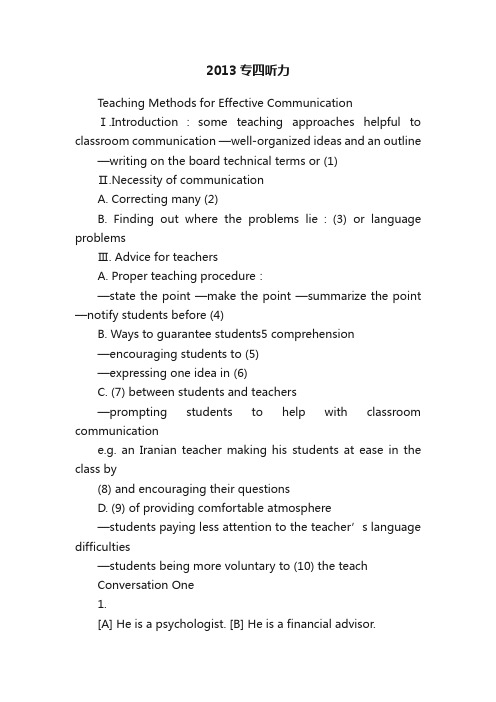
2013专四听力Teaching Methods for Effective CommunicationⅠ.Introduction:some teaching approaches helpful to classroom communication —well-organized ideas and an outline —writing on the board technical terms or (1)Ⅱ.Necessity of communicationA. Correcting many (2)B. Finding out where the problems lie:(3) or language problemsⅢ. Advice for teachersA. Proper teaching procedure:—state the point —make the point —summarize the point —notify students before (4)B. Ways to guarantee students5 comprehension—encouraging students to (5)—expressing one idea in (6)C. (7) between students and teachers—prompting students to help with classroom communicatione.g. an Iranian teacher making his students at ease in the class by(8) and encouraging their questionsD. (9) of providing comfortable atmosphere—students paying less attention to the teacher’s language difficulties—students being more voluntary to (10) the teachConversation One1.[A] He is a psychologist. [B] He is a financial advisor.[C] He is a psychiatrist, f w [D] He is a best-selling author.2. [A] 50%. [B] 75%. [C] 80%. [D] 85%.3.[A] Many people have trouble in keeping and spending money wisely.cessarily bring happiness to people.[B] Money doesn’t ne[C] The more money you earn,the happier you will be.[D] Money brings comparatively more happiness to the low income class.4.[A] The teacher. [B] The social worker.[C] The fire fighter. [D] The manager.5.[A] Having someone who loves you.[C] Having a successful marriage.[B] Being healthy mentally and psychologically.[D] Having filial children.Conversation Two[A] Regrets are very annoying for people. [A] Regrets are very wonderful for people.[C] Regrets are very common to people. [D] Regrets are very puzzling to people.7.[A] It’s very simple. [B] It’s very difficult. [C] It’s impossible. [D] It depends.8.[A] Guilt hinders you from acting. [B] Guilt is a merciless blow in the past.[C] Regret is something we should repress. [D] Regret makesus take action.9.[A] Having a view shift towards regret.[B] Identifying the regret.[C] Doing something to change the present situation.[D] Forgetting all about the regret.10.[A] The difference between guilt and regret. [B] The right way to deal with regret.[C] The mistaken view we hold on regret. [D] The definition of regret.What Are Dreams for?One theory is that we dream to release the deep, secret desires. / Another theory is that dreams allow us to solve problems / that we can’t solve in real life. / We go to sleep with a problem and wake up with the solution. / If you believe that your dreams are important, / then analyzing them may help you to focus on the problem / and help you to find the solution. / The hard disk. /way of cleaning up the computer’smodern im age is that dreams are the brain’sDreams organize the events of the day into folders / and delete what is not needed.Teaching Methods for Effective CommunicationGood evening,everyone. A few months later,you will start to teach international students. T oday,we will talk about the teaching methods of effective communication.Teaching methods can help increase communication effectiveness. Clearly organizing ideas and writing an outline on the chalkboard that lists the main points to be covered duringthe class helps students follow along with the organization of ideas. (1) It is also very helpful for students when teachers write technical terms or theoretical concepts on the board as they are mentioned. Students need and appreciate this effort.classroom is necessary. (2) By setting Student participation in the international teacher’saside class time for students to explain and discuss their understanding of the course materialand the teacher's lecture or explanations? many communication errors can be corrected beforethey interfere with student learning.Of course,some difficulties may be assumed to result from language problems when in fact the problem lies elsewhere. (3) When students don’t understand,it could be a language problem,important to but it also could be that the teacher doesn’t have good teaching skills. So it’s communicate with students to find out what the problem is.Using effective teaching methods does facilitate classroom communication. As teachers with teaching experience in their native countries already know, when lecturing, it is important to clearly state each point before speaking about it, make the point and then summarize what hasbeen said. (4) Before beginning another idea or point,it,s necessary to inform students of thischange or transition.Students are reluctant to continually ask teachers to repeat what they’ve said, even when they haven't completely understood the teacher. (5) Thus, it is important for teachers to frequently stop to if students have any questions. (6) Anothermethod often used by bothinternational and American teachers is presenting the same idea in more than one way.Many effective teachers learn to elicit the help of their students. (7) If the teacher andstudents have a friendly relationship, students usually are more willing to help facilitatecommunication in the classroom. In the following statement a teacher from Iran described howhe uses certain teaching methods to be sure his students understand him.“I’ve been trying hard to say the words separate so that students can understand. (8) Oncein a while I stop and ask, ‘Do you follow?’ and pretty much make them feel that any time they canstop me. ”(9) Getting students to participate in the class by being friendly and supportive of theircomments, ideas,and questions can help both the teacher and the students feel morecomfortable in the classroom. (10) When students feel comfortable enough to participate in class,ge difficulties and be willing to cooperate witht hey may be more tolerant of the teacher’s languathe teacher in solving communication problems.Today, we’ve t alked about ways for you, future international teachers, to enhancecommunication in the classroom. I hope you would have a good time.对话1W. Can money really buy happiness? (1) Best-selling author David Bach is a psychiatrist and amoney advisor on CNBC s The Millionaire Inside. Going from rags to riches,he says he foundhappiness but it wasn’t just abou t dollars and cents. Morning,David.M:Good morning, Maggie.W: What do you think makes people happy then, if they have no money?M: Well,I think what most Americans really want is freedom.(2) We are in the land of thefree,but when three out of four people are living paycheck to paycheck,they don’t feel free.W:You also say that happiness is not as simple as making more money.M:Yes. The more money you have,the more you need to spend anyway. (3 -1) Peopledon’t know how to keep their money. And people don,t know how to spend it wisely.W:We spend so much time in our lives trying to make money. We must believe it’s going tobring us happiness. But the research you have ever done about it is kind of mixed, isn’t it?M: Well,the research is mixed. (3 - 2) And I think part of the reason for that is that peopleacknowledge in their souls,if not in their wallets, that it won’t make them happy.W: But the problem is we see all these people out there today, with the yachts, with theboats, all of these, the planes, the big houses. They lookhappy, they have all these possessions.How do you explain that?M. It looks that way. But the research also indicates about scale. (3-3) You can givesomebody enough money to take them from poverty to middle class,which makes people happy.But a lot more money % to from five hundred thousand to five million,doesn't make them happy.W: I agree. (3-4) Money is going to have the more significant impact on those low incomeindividuals.M: I have never had anybody who comes in and says that he or she needs a little moremoney.listened to the surveys of the kinds of jobs that make people the happiest; (4) the W: I’vejobs that pay the most money. They are things like teachers* social workers, firefighters, notnecessarily highly-paid jobs.M: Absolutely true. (5-1) It’s really about feeling loved.W: (5-2) Good, passion is another thing that makes people happy. Health and passion.M:Yes. Health is at the top of the list in terms of what makes you happy. (5-3) Having goodrelationships with people,having a lot of very close personal friends, having a good marriage.These are the types of things that make people happy. So if you flip that around, then you’ll getto the core of what really makes people happy. (5-4) Sometimes you have to take the negative tosee that you are content now. So if people were to imagine:I’m not going with it these moments,then they would realize that they are pretty content even though their car is a year-older thanthey’d like.W:Yes, no question. Well again,the age-old question, we continue to debate it still. David,thanks.M:Thank you, Maggie!1. Which of the following is INCORRECT about David Bach?2. What percentage of people in the US are living under the pressure of money?3. Which of the following statements about money is INCORRECT?4. Which of the following jobs probably brings the least happiness to people?5. What is NOT mentioned in the interview as to bringing happiness to people?Conversation TwoW:We brought in a person to help us understand what regrets are all about. ReverendSherri Hausser is an associate pastor in Pennsylvania. Nice to have you here.Ms Thank you.W :We talked about this that everybody on the staff said we should do a segment aboutregrets. Why?M:(6) Regrets are amongst the most human things we have:this amazing invitation andopportunity to grow.W:But immediately you say regrets are positive, and most people don’t think that way.Most people think that regrets are negative.M:Yeah, that’s true. (8-1) I think that the important thing about regret is not to repress it. Ithink it starts to bother us, and it inhibits us from acting if we don’t acknowledge it.W:So you say, “OK, I’ve got a regret. All right. Here is what I did in a personal relationship.Here is what I sai d to a person and I wished I hadn’t said it.”Now, get off your butt, and changeit. So, if you made someone upset, you go and apologize. Is it as simple as that?M:(7) Well, sometimes it is as simple as that. I mean, it depends again on what the regretis about. You can’t do anything about the past. But the regret is really about right now. What do Iwant different about this relationship that I,m in? And sometimes that means I don’t want to beut it isin this relationship anymore, and I have to act that way, and that’s a very serious thing, b regret is a yearning about the future, and a yearning to be more.W;What’s the difference between regret and guilt?M: (8-2) I would say that guilt is something that we used to beat ourselves up with. It’s something t hat actually stalls us and keeps us from acting. Regret on the other hand,is really an opportunity toward action. If we articulate it,then we,re compelled to do something different about it. And it really is an opportunity.W:What do you say to those who are out there living with regrets for years?M:I would say:(9-1) you have to have a shift in perspective. The second you feel that regret,you may think “Oh my God,an amazing opportunity right now,to grow,to develop, to discover something new about myself.”(9-2) To be specific,I would say that the first thing youdo is to identify it. The second thing is that if it is something that is past, that you can’t reclaim ina certain way, you have to grieve it. The third thing is by grieving, you free yourself up to say:what can I do now? If it’s that I didn’t have a child,maybe I can adopt one. If I can't adopt,maybeI can engage the children in my life, my niece,s,my nephew,s, other people’s children, volunteer with children. It,s a way to really manifest part of o urselves that’s been repressed and th at we’ve wanted to inform.W: I’m going to make that one the last word. I regret we’re out of time, so thanks very much.M:Glad to be here.6. Why is talking about “regrets” necessary?ations brought about by things7. What is Reverend’s opinion concerning changing the situwe regret?8. Which of the following statements about guilt and regret is INCORRECT?suggestion for people living with regrets for9. Which of the following is NOT Reverend’syears?10. What does the interview mainly focus on?。
20132014学年度第一学期全日制科学

2015-2016学年度第二学期全日制学术学位硕士英语课程B组分班情况表(781人)B组1xx法学院(法学理论6人,国际法学13人,宪法学与行政法学10人,刑法学8人,民商法学18人,诉讼法学4人,),共59人B组2xx法学院(环境与资源保护法学9人,经济法学7人),音乐学院(所有2015级全日制科学学位硕士研究生),共65人B组3xx公管院(马克思主义哲学4人,美学4人,宗教学3人,科学技术哲学3人,科学社会主义与国际共产主义运动6人,伦理学13人,国际政治3人,马克思主义基本原理6人,马克思主义中国化研究5人,社会保障8人,人类学2人,人口学2人),共59人B组4xx公管院(社会学11人,思想政治教育19人,政治学理论8人,行政管理23人,中国哲学5人),共66人B组5xx公管院(外国哲学4人,中外政治制度5人,中共党史5人),新传院(所有2015级全日制科学学位硕士研究生)共67人B组6xx文学院(课程与教学论6人,文艺学8人,语言学及应用语言学6人,汉语言文字学32人,中国古典文献学5人,比较文学与世界文学6人),共63人B组7xx文学院(中国现当代文学34人,中国古代文学23人,美术学5人,写作学5人),共67人。
B组8xx文学院(对外汉语12人,戏剧影视学13人,艺术理论5人);旅游学院(旅游管理34人),共64人B组9xx历文院(所有2015级全日制科学学位硕士研究生),共67人。
B组10xx商学院(所有2015级全日制科学学位硕士研究生),共56人。
B组11xx教科院(比较教育学5人,高等教育学22人,教育史3人,教育学原理10人,学前教育学10人,),共50人。
B组12xx教科院(教育技术学10人,教育经济与管理12人,课程与教学论16人,少年儿童组织与思想意识教育2人,职业技术教育学4人);国汉院(对外汉语7人),共51人。
B组13xx教科院(心理学47人),共47人。
西文理校发〔2013〕135号
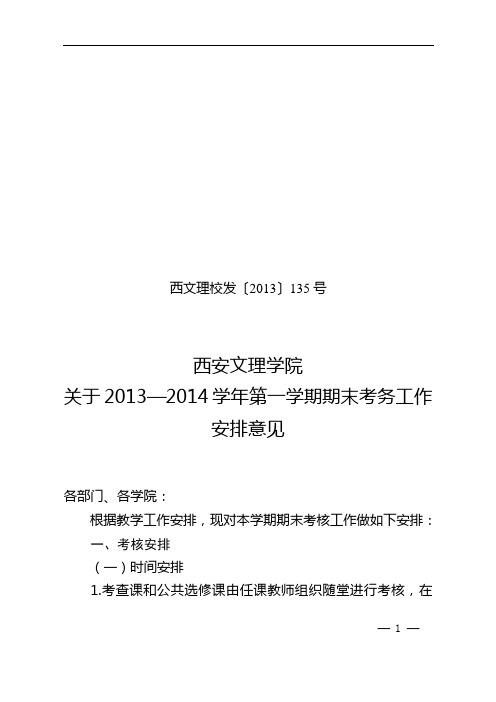
西文理校发〔2013〕135号西安文理学院关于2013—2014学年第一学期期末考务工作安排意见各部门、各学院:根据教学工作安排,现对本学期期末考核工作做如下安排:一、考核安排(一)时间安排1.考查课和公共选修课由任课教师组织随堂进行考核,在— 1 —18周完成。
《大学信息技术基础》理科类专业根据课程改革需要,学校统一安排笔试时间(见附件2)。
2.考试课期末考试安排在2014年1月9日至1月17日(第19周周四至第20周周五),考试时间一般以120分钟计,时段《期末考务工作进程表》见附件1,公共基础课全校统一安排考试时间见附件2、3,专业必修课由各学院在规定时间内自行安排。
重修考试原则上由开课学院随正常期末考试进行,个别人数较多的公共课重修考试或其他特殊情况,时间如确需调整,可报书面材料由教务处审批。
(二)考试安排各学院按学校统一格式制作期末考试安排表,务必包含本学期全部考试课程,不得遗漏、重复或冲突,考试科目名称必须与人才培养方案中的课程名称一致,专业、班级、时间及人数等务必保证准确完整。
期末考试安排表须经学院领导认真审核无误,签字盖章后,将电子、纸质各一份报送教务科。
(三)考核改革各学院要根据专业和课程特点认真研究,积极探索与人才培养计划相适应的考核改革,推进累加式、重能力、突出应用性的— 8 —考试制度,强化过程考核与目标考核相结合,通过大作业、课程设计、课程论文、阶段测试,以及开卷考试、口试、笔试、网络考试等多样化的考核方式和手段,充分发挥学生的创造性和个性,实现“以学生为本”,真实体现学生的知识、能力和素质,力求从根本上改变“一考定成绩”的简单考核办法,实现考核过程全程化、考核形式多样化、考核内容能力化、试卷分析规范化、考核反馈及时化、考核档案系统化的目标。
请各学院于2013年12月9日(周一)之前将实施考核改革的具体情况以书面形式报教务处。
二、试题的命制与交接(一)命题要求命题前,各学院、教研室要组织召开全体教师会议,研究在命题中如何落实地方性、应用性、科学性和规范性的要求。
2013年高等学校英语应用能力考试
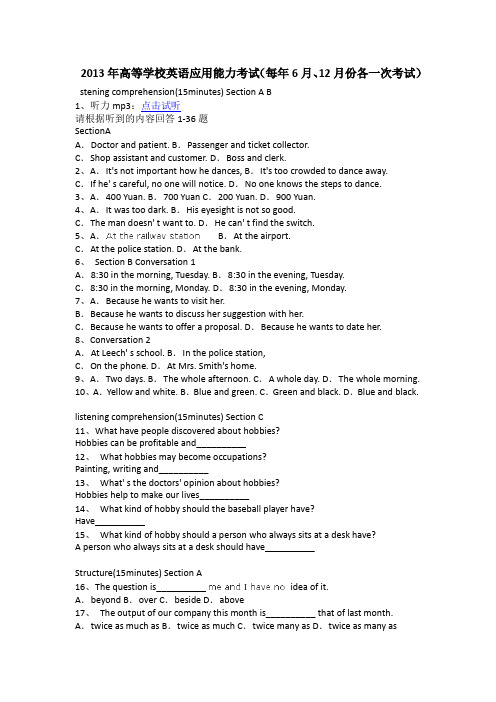
2013年高等学校英语应用能力考试(每年6月、12月份各一次考试)stening comprehension(15minutes) Section A B1、听力mp3:点击试听请根据听到的内容回答1-36题SectionAA.Doctor and patient. B.Passenger and ticket collector.C.Shop assistant and customer. D.Boss and clerk.2、A.It's not important how he dances, B.It's too crowded to dance away.C.If he' s careful, no one will notice. D.No one knows the steps to dance.3、A.400 Yuan. B.700 Yuan C.200 Yuan. D.900 Yuan.4、A.It was too dark. B.His eyesight is not so good.C.The man doesn' t want to. D.He can' t find the switch.5、A. B.At the airport.C.At the police station. D.At the bank.6、Section B Conversation 1A.8:30 in the morning, Tuesday. B.8:30 in the evening, Tuesday.C.8:30 in the morning, Monday. D.8:30 in the evening, Monday.7、A.Because he wants to visit her.B.Because he wants to discuss her suggestion with her.C.Because he wants to offer a proposal. D.Because he wants to date her.8、Conversation 2A.At Leech' s school. B.In the police station,C.On the phone. D.At Mrs. Smith's home.9、A.Two days. B.The whole afternoon. C.A whole day. D.The whole morning.10、A.Yellow and white. B.Blue and green. C.Green and black. D.Blue and black. listening comprehension(15minutes) Section C11、What have people discovered about hobbies?Hobbies can be profitable and__________12、What hobbies may become occupations?Painting, writing and__________13、What' s the doctors' opinion about hobbies?Hobbies help to make our lives__________14、What kind of hobby should the baseball player have?Have__________15、What kind of hobby should a person who always sits at a desk have?A person who always sits at a desk should have__________Structure(15minutes) Section A16、The question is__________ idea of it.A.beyond B.over C.beside D.above17、The output of our company this month is__________ that of last month. A.twice as much as B.twice as much C.twice many as D.twice as many as18、Hardly had I got home __________the telephone rang.A.then B.when C.as D.than19、By the time you get back, I __________all the work.A.would finish B.will have finished C.has finished D.had finished20、It' s required that the students__________the term paper tomorrow. A.finished B.finish C.will finish D.may finish21、__________ the final examination is over, we can go outside for a picnic. A.Even though B.Now that C.For D.With22、Tom was the only one of the students who__________named Outstanding Student.A.is B.are C.was D.were23、There is something wrong with my car. It will take me one hour to have it__________A.fix B.fixing C.to fix D.fixed24、Seldom __________his wife punishes her children for speaking out their own ideas freely.A.I saw B.I have seen C.have I seen D.do I see25、It' s high time the government_ ____ to raise people' s awareness of environmental protection.A.will take B.take C.took D.takesStructure(15minutes) Section B26、I remember __________(see) her last year at Mary' s birthday party.27、Students would rather try once again than __________ (give) up the plan.28、The teacher__________(able) his students to master the new words by making up sentences.29、Scientists have done a lot of study to show that praise is far__________(effective) than criticism in improving students' behavior.30、The secretary was in a good mood because her__________(propose) was accepted by the general manager,31、Time __________( permit), my husband and I are going to the cinema on Christmas Eve.32、It can __________ (believe) that there is no life without water.33、I see so many__________(love) children every day since the kindergarten is in front of my house.34、He told me her name only after I __________ (ask) her twice.35、If Robinson __________(learn) how to swim, he wouldn' t have been trapped on that island.36、请根据以下内容回答36-41题The business cycle is made up of many phases and one of them is the expansion phase which is divided into two parts--recovery and prosperity,During the recovery period there is a growing expansion of existing equipment. And new facilities for production are created. More busines~s are created and older ones expand. Many kinds of important improve- ments are made. People hold increasingly positive view about the future of economicgrowth. in machinery or "heavy" industry. More labor is employed, More raw materials are required.As more economy departments develop, other departments are affected. For example, the expansion in automobiles results in an expansion of the steel and rubber indusWies. Roads are required; thus the cement and machinery industries are activated. Demand for labor and materials results in greater prosperity for workers and suppliers of raw materials. This increases the amount of goods bought and sold. This prosperity can be seen among the various parts of the population.This prosperity period may continue to rise without an obvious end, However, when this phase reaches a peak and stops going upwards, it is the end of the expansion phase. Which of the following will happen in economic recovery?A.The expansion of existing facilities. B.The creation of new business.C.The increase of optimism about the future of economy. D.All the above.37、The word "affected" in para. 3 means __________.A.effect B.changed C.influenced D.involved38、Which of the following is TRUE according to the passage?A.Sections of economy do not influence each other.B.In the expansion phase the business maintains development in the long rtm. C.The end of the business in the prosperity period can be obviously seen.D.Parts of economy are closely related to each other.39、We can infer from the last paragraph thatA.the end of one business expansion will certainly happenB.the business can expand endlesslyC.economic expansion is fast D.economic rise to the peak is slow40、 mainly about?A.development of economy B.recovery of economyC.expansion of economy D.prosperity of economy41、请根据以下内容回答41-46题Normally a student must attend a certain number of courses in order to graduate, and each course which he attends gives him a credit which will be counted towards a degree. In many American universities the total work for a degree consists of thirty-six courses, each lasting for one term. A typical course consists of three classes per week for fifteen weeks;a student will probably attend four or five courses during each term while attending a u- niversity. Normally a student may expect to take four years attending two semesters each year. Of course, they can work for the degree over a longer period. It is also possible for a student to move between one university and another during his degree course, though this is not in fact done as a regular practice.Every course that the student takes will be given a grade, which is recorded and available for the student to show to their prospective employers. All this imposes a constant pressure and strain of work on students. But some students still spare their time to take part in the student affairs. Elections to positions in student organiza- tions arouse much enthusiasm. The effective work of maintaining discipline is usually performed by studentswho advise the academic authorities. Any student who is thought to have broken the rules, for example, by cheating, has to appear before a student court. With the large numbers of students, the operation of the system does include a certain number of activities. A student who has held one of these positions of authority is much respected and it will be helpful to him later in his career.Normally a student would at least attend __________ classes each week.A.36 B.16 C.30 D.1242、According to the first paragraph an American student is allowed__________ A.to live at home and drive to classes B.to live in a different universityC.to take a particular course in a different universityD.to get two degrees from two different universities43、American university students are usually under pressure of work because__________ A.their academic performance will affect their future careersB.they student affairsC.they have to observe university disciplineD.they want to run for position of authority44、What can we infer from the passage?A.Students in American universities normally under great pressure.B.Students are active in taking part in students organizations.C.American universities are hard for students to get the degree.D.The academic authorities have done a lot of study on self-discipline of the students in universities.45、Some students are enthusiastic for position in student organizations probably because__________A.they hate the constant pressure and strain of their studyB.they will then be able to stay longer in the universityC.such positions help them get better jobs D.such positions are usually well-paid Reading Comprehension(40minutes) Section C D E46、请根据以下内容回答46-51题Welcome to visit our company and I am very glad to have the opportunity to introduce our company to you all. Our company was established in 1990. We specialize in manufacturing household electrical appliances and exporting them all over the world. Our annual sales of last year is about 80 million dollars, and the business is growing steadily. We have branches in North America and Europe with about 500 employees, and they are working diligently to serve the needs of our customers.In order to further develop overseas market, we need reliable agents to promote our products. I hope you will seriously consider doing business with us. Thank you.The company specializes in the field of 46 __________47、The sales of last year is about 47__________48、The company has branches in North America and 48__________49、There are about 49__________ people are employed.50、The purpose of this introduction is to 50__________51、请根据以下内容回答51-56题A—planned economy I—seller' s marketB—market economy J—buyer' s marketC—World Trade Organization K—International Business LawD—sales promotion L—economic recoveryE—negative trade balance M—international settlementF—retailing and wholesaling N —way of paymentG—inflation O—way of settlementH—favorable trade balance P—economic crisisExamples: (A) 计划经济( M )国际结算()通货膨胀()促销52、()批发与零售()卖方市场53、()世界贸易组织()国际商法54、()结算方式()贸易顺差55、()支付方式()市场经济56、请根据以下内容回答{TSE}题Job AdvertisementOur company is Tianhe Automobile Company and we are seeking for a mature, competent secretary whose main responsibility is to report to the general manager. The applicant should be skillful in organization work, shorthand and data processing, good at computer and fluent in English. Besides, the applicants should have at least two-year working experience and can work well with different colleagues. The company will offer excellent opportunities for personal development, a wide range of benefits and good career development opportunities.The salary will be in accord with qualifications, beginning at a mmimum of $ 2,500 per month. The opportunity for this post wilt be equal for both women and men. Interviews will be held on Monday to Friday, from June 14th to 18th. Resumes together with a photo are requested to mail to:Human resource departmentTianhe Automobile CompanyPO Box 650Windsor. Ontario M60358What' s the name of the company?____________________ Company57、What qualifications should the applicants have?They should be good at____________________, shorthand, data processing, computer and English.58、What will the company offer to their potential employees?We will offer personal development, a wide range of benefits and good____________________59、When will the interviews be held?From ____________________of June.60、What is required to mail to Tianhe together with their resumes?_______________________。
固液界面能差效应与冷凝传热强化研究进展_马学虎
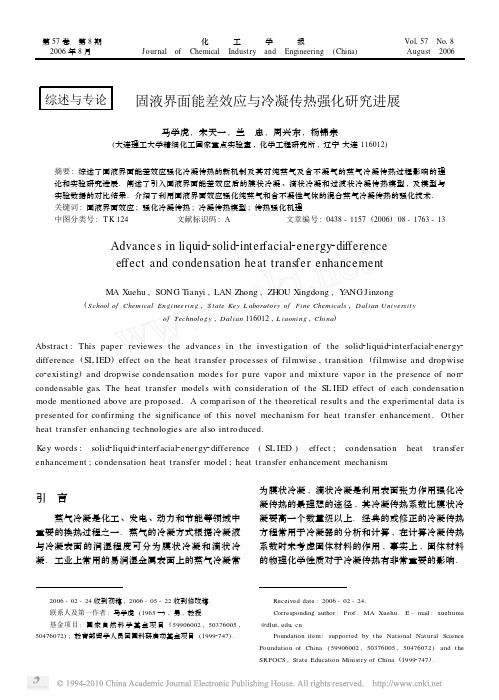
第57卷 第8期 化 工 学 报 Vol 157 No 18 2006年8月 Journal of Chemical Industry and Engineering (China ) August 2006综述与专论 固液界面能差效应与冷凝传热强化研究进展马学虎,宋天一,兰 忠,周兴东,杨锦宗(大连理工大学精细化工国家重点实验室,化学工程研究所,辽宁大连116012)摘要:综述了固液界面能差效应强化冷凝传热的新机制及其对纯蒸气及含不凝气的蒸气冷凝传热过程影响的理论和实验研究进展.阐述了引入固液界面能差效应后的膜状冷凝、滴状冷凝和过渡状冷凝传热模型,及模型与实验数据的对比结果.介绍了利用固液界面效应强化纯蒸气和含不凝性气体的混合蒸气冷凝传热的强化技术.关键词:固液界面效应;强化冷凝传热;冷凝传热模型;传热强化机理中图分类号:T K 124 文献标识码:A 文章编号:0438-1157(2006)08-1763-13Advance s in liquid 2solid 2interfacial 2energy 2differenceeffect and condensation heat transfer enhancementMA Xuehu ,SONG Tianyi ,LAN Zhong ,ZHOU X ingdong ,Y ANG Jinzong(School of Chemical Engineering ,S tate Key L aboratory of Fine Chemicals ,Dalian Universit yof Technology ,Dalian 116012,L iaoning ,China )Abstract :This paper reviewes t he advances in t he investigation of t he solid 2liquid 2interfacial 2energy 2difference (SL IED )effect on t he heat t ransfer p rocesses of filmwise ,t ransition (filmwise and dropwiseco 2existing )and dropwise condensation modes for p ure vapor and mixt ure vapor in t he presence of non 2condensable gas 1The heat t ransfer models wit h consideration of t he SL IED effect of each condensation mode mentioned above are p ropo sed.A comparison of t he t heoretical result s and t he experimental data is p resented for co nfirming t he significance of t his novel mechanism for heat transfer enhancement.Ot her heat t ransfer enhancing technologies are also int roduced.Key words :solid 2liquid 2interfacial 2energy 2difference(SL IED )effect ;condensationheatt ransferenhancement ;condensation heat t ransfer model ;heat t ransfer enhancement mechanism 2006-02-24收到初稿,2006-05-22收到修改稿.联系人及第一作者:马学虎(1965—),男,教授.基金项目:国家自然科学基金项目(59906002,50376005,50476072);教育部留学人员回国科研启动基金项目(19992747). 引 言蒸气冷凝是化工、发电、动力和节能等领域中重要的换热过程之一.蒸气的冷凝方式根据冷凝液与冷凝表面的润湿程度可分为膜状冷凝和滴状冷凝.工业上常用的易润湿金属表面上的蒸气冷凝常为膜状冷凝,滴状冷凝是利用表面张力作用强化冷凝传热的最理想的途径,其冷凝传热系数比膜状冷凝要高一个数量级以上.经典的或修正的冷凝传热方程常用于冷凝器的分析和计算,在计算冷凝传热系数时未考虑固体材料的作用,事实上,固体材料的物理化学性质对于冷凝传热有非常重要的影响. Received date :2006-02-24.Corresponding author :Prof.MA Xuehu.E -mail :xuehuma @dlut 1edu 1cnFoundation item :supported by t he National Natural Science Foundation of China (59906002,50376005,50476072)and t he SRFOCS ,State Education Ministry of China (19992747).从液体和固体之间的微观作用出发的研究还需要做大量的工作.因此从固液界面和气液界面相互间的微观作用以及冷凝液在固体表面的运动规律着手,揭示固体和液体的表面自由能差对于液体(或冷凝液)在固体表面上的凝聚型态及其微观运动行为的影响,进而阐明液固表面自由能差强化蒸气冷凝传热的物理本质,对于进一步深化冷凝传热理论和开发新一代传热表面具有重要的意义.本文将基于固液界面能差效应强化冷凝传热的新思路,从冷凝型态的判据、不同冷凝型态传热模型以及过程、强化冷凝传热方法等方面综述近年来的研究结果.对于国内外的相关文献也根据需要做了适当的引用.1 冷凝型态表面自由能差判据及其传热机理 蒸气在固体表面上冷凝方式的判据过去大多采用静态接触角,接触角小于90°时形成膜状冷凝,反之形成滴状冷凝[122].然而,由于实际固体表面物理性质和化学性质的非均匀特性,在绝大多数情况下实验观察和测量到的接触角不是惟一确定的,而是有一个变化范围,周兴东等[3]在小于90°的静态接触角条件下也实现了完全滴状冷凝,因此一些学者认为以平衡接触角作为冷凝型态的判据在实际应用中并不方便[4],并且有很大的局限性[5].Min 和Webb [6]提出了以后退角是否大于40°作为发生滴状冷凝的判据,而岳丹婷等[7]则认为表观接触角大于150°是实现滴状冷凝的充分条件.曹治觉等[8]对微米级的小液滴进行受力分析求出滴状冷凝过程中的最佳接触角为120°,并在文献[9]中证明了如果降低壁面过冷度以及采用适当措施降低壁面液滴的脱落半径,实现稳定的小接触角的滴状冷凝也是可能的.赵起[10]采用量子化学中的扩展Huchel 分子轨道理论计算了水、乙醇的内聚能以及它们与铜基离子注氮表面和铜基硬脂酸钡单分子膜的表面吸附能,当吸附能小于内聚能时冷凝将呈现滴状型态,反之为膜状冷凝1这种方法的计算量和某些参数的不确定性都很大,因此也影响了判别的准确性.马学虎等[11]从润湿的观点出发,提出了蒸气在固体表面上冷凝方式的固液表面自由能差判据,如表1所示.表中Δσ=σl -σs .T able 1 Condensation mode criterionΔσ/mJ ・m -2θH 2O /(°)Condensation mode ≤00—3313<90film condensationmixing condensation ≥3313≥90dropwise condensation冷凝表面的表面自由能仅与表面组成、结构有关,与接触角的测量温度无关,因而,表面自由能差Δσ的计算不受接触角测量温度的制约,仅随冷凝温度等操作条件的变化而变化,这是本判据较通常接触角判据的主要优势所在.刘旭和徐敦颀[12]的实验表明,经过改性处理的具有低表面能的Cu 2B TA 表面可以使处于膜状冷凝状态的乙二醇冷凝传热能力提高20%.这些实验虽然已发现当接触角小于90°时,接触角的变化会对冷凝产生影响,但人们还未针对液固表面性能对强化冷凝传热的机理进行深入的研究.马学虎等[13]认为在一定的表面过冷度条件下,冷凝传热特性随冷凝液与冷凝表面自由能差Δσ的变化关系应存在两个临界值,在两个临界值之间的冷凝传热特性是渐进变化的,而非到第二临界点处发生突变,如图1所示.相应地,冷凝型态也将从开始的膜状冷凝、经过滴膜共存沟流型态最后转变为完美的滴状冷凝.在判据表中的过渡冷凝状态,表面强化传热的效果将取决于表面自由能差值的大小,差值越大,强化效果越明显.这就为表面自由能较低的有机蒸气的强化冷凝传热表面的选择提供指导性依据.通过选择合适的表面涂层达到适宜的冷凝强化传热效果.同时,引入固液界面能差效应的概念,可以从一种全新的角度来理解传热表面特性强化冷凝传热的物理本质[14216].Fig 11 Effect of solid 2liquid interfacial 2energy 2difference on condensation heat transfer兰忠等[17]研究了常压下不同过冷度、不同浓度的乙醇2水混合蒸气冷凝传热过程,发现不同表・4671・化 工 学 报 第57卷 面过冷度下,由于凝液组成的变化引起“拟固液表面自由能差”的变化.相应地,随着固液表面自由能差的变化,冷凝型态也经历膜状、过渡状最后到滴状的变化过程,如图2所示,并伴随有相应的传热性能变化.从界面效应强化冷凝传热的新机制,合理地解释混合蒸气冷凝传热型态转化的规律,结合文献数据初步得到了乙醇2水混合蒸气的冷凝型态转变条件.Fig 12 Photographs of condensationmodes on copper plate2 膜状冷凝强化传热的表面自由能差机制 目前,膜状冷凝在工业生产中已得到了大规模的应用,其传热机理研究已经相当成熟,人们可以采用各种方法强化膜状冷凝的传热能力.原则上,强化膜状冷凝传热的途径主要是增大传热面积和利用表面张力作用减薄冷凝液膜,后者多数是通过改变冷凝表面的几何形状来实现的.211 膜状冷凝的传热机理Nusselt 于1916年提出了膜状冷凝层流流动模型,得出膜状冷凝传热系数公式[17]h =01943λρ2gk 3LμΔT 1/4(1)该模型隐含了冷凝壁面的表面能远大于冷凝液表面自由能的假定,即可以忽略液固相界面的相互作用.当液体能很好润湿固体壁面时,该模型可以较好地描述冷凝液流动状态和计算冷凝传热特性.事实上,当冷凝液与固体壁面的浸润性变化时,Nusselt 模型会与实际情形产生一定的偏差.在冷凝体系中,当冷凝液量较大时,凝液覆盖固体壁面,形成连续液膜.随着流量的减小,由于固液界面作用力的影响,连续液膜就可能发生破裂,形成局部干斑,或液膜收缩形成沟流.可以看出,固体表面材料的物理化学性质对液膜流动的最小液膜厚度和最小流率有主要的影响,大量学者的研究报道也证实了这一点[18226].Doniec [20221]分析认为沟流截面形状是由能量最小原理作用的结果(图3),并形成与能量方程有关的未知形状,不能简单人为认定是某个几何形状.研究者假设液体表面平滑无波动,无流向上的混流,液体作层流运动,物性参数恒定,重力势能抵消黏性耗散(说明匀速运动,总能量由动能和表面能量构成).这样的沟流系统具有轴对称截面,截面边界与固体壁面呈固液平衡接触角.求得沟流液膜最大厚度为δ=4571/5μ2γl v ρ3g21/5(1-cos θ0)1/5(2)研究者认为当流率增加时,液体仍以此最大厚度存在,只是宽度加大,形成一定宽液膜.研究结果发现临界液膜厚度(流率减小以致使膜要发生破裂或收缩形成沟流时的临界流率下的临界膜厚度)是平衡接触角的函数.Fig 13 Liquid flow in a revuletMahnke 等[27]测定了疏水表面上临界膜厚度,结果表明当接触角小于45°时,临界膜厚随接触角增大而增大,但当接触角超过45°时,影响不大,研究者认为此时疏水作用是膜破裂的主要成因,表面因素是影响膜破裂的重要因素,特别是对极薄液膜分子作用力是最重要因素.212 膜状冷凝传热强化的液体表面张力原理Gregorig 提出利用液体表面张力的方法来强化竖直表面的层流膜状冷凝.冷凝截面形状如图4所示,冷凝过程主要发生在中间突出部分的顶部,・5671・ 第8期 马学虎等:固液界面能差效应与冷凝传热强化研究进展表面张力的作用使冷凝液流向凹槽内,凹槽则成为排液通道.Fig 14 Section of condensing surface of GregorigGregorig 所提出的方法成为了膜状冷凝传热强化的基础[28],其强化核心思想是通过改变冷凝表面的几何形状来改变冷凝液膜流动特性,减薄液膜主体厚度,减小热阻,同时还能增大一部分传热面积,从而达到强化膜状冷凝传热的目的.得到大规模应用的管型主要有螺纹管、纵横槽管、锯齿管、错齿圆翅片管、波形曲面凹槽管、垂直余弦形沟槽管、V 形纵槽管、垂直光管设置纵向金属丝、立式螺旋槽管和小螺旋角的内外螺旋三角翅片管等[28230].213 膜状冷凝传热强化的固液界面能差效应马学虎等[31]研究了界面效应对降液膜平均厚度的影响,认为固液界面效应是影响降液膜平均厚度的重要因素之一.从液膜流动的角度出发,考察液体表面自由能以及接触角对液膜厚度的影响,基于Doniec [20221]建立的模型,利用最小能量原理,推导出适用于圆形竖直表面的修正膜状冷凝传热系数计算公式[13]α=019284λh fg ΔtR1/2gρ4σ2μ1/101-cosθ1/5(3)Fig 15 Effect of surface subcooling degree oncondensation heat transfer coefficientfor various contact angles计算结果表明传热系数随温差的增大而减小,当温差一定时,接触角越大,传热系数越大.由图5可以看出,当接触角较小时,该模型计算结果与Nusselt 计算值符合较好;而当接触角较大时,模型计算结果高于Nusselt 计算值.3 滴状冷凝传热的固液界面能差效应滴状冷凝传热过程是一个由液滴的生成、长大、合并和脱落4个随机的子过程组成的不稳定的循环过程,而且各个子过程之间相互影响、相互制约.因此,完整地理解滴状冷凝过程循环的基本子过程及其相互关系是滴状冷凝传热研究的重要内容.311 初始液滴的形成初始液滴生成机制有两种假说:J akob 首先提出的膜破裂假说和Eucken [32]提出的固定成核中心假说,后者已被大多数学者所认同,并进行了实验验证[33234].Song 等[35]从吸附的观点并结合成核基本理论提出了滴状冷凝过程中初始液滴生成的滴膜共存机制.在冷凝表面上存在大量不同尺寸并按一定规律分布的冷凝液滴,液滴之间存在一定厚度的薄液膜,液滴脱落或因合并移位后,原位置仍保留一层薄液膜.并利用反射光谱法对上述设想进行了实验验证.Majumdar 等[36]、Haraguchi 等[37]的研究也证实了液滴在液体薄膜上产生的观点,膜厚大约是011~013μm.Hijikata 等[38]发现当水2乙醇二元蒸气在平板上冷凝时,冷凝液膜部分增长并最终在膜上形成小滴,而且液滴每次都在同一点开始形成.312 液滴尺寸分布液滴尺寸分布和液滴型态的确定对滴状冷凝的机理研究和传热计算有重要意义.过去对这一问题的处理和研究方法有假定尺寸分布、对液滴成长过程进行模拟、对滴状冷凝过程进行图像采集并作统计分析等.Tanasawa [39240]利用高速摄影和显微放大照相技术研究了液滴分布情况,提出液滴尺寸在区间[r ,r m ]中,被液滴覆盖的壁面面积分率为A (r )=1-r r mn(4)其中n 取值在01313~01350之间.Rose 和Glicksman [41]认为最大的液滴尺寸几乎相同而等距,用序列事件模型推导尺寸分布,与该式相似,n =01382.Hijikata 等[38]、Tanaka [42]也都得到了类似的结果,液滴分布可能是惟一确定的,与液滴的生长或合并过程的随机性关系不大.Monsa [43]・6671・化 工 学 报 第57卷 认为在液滴从生成到发生合并前经历不同尺寸,在液滴尺寸范围(r 1,r 2)中,液滴数目处于平衡,从而以众数平衡(pop ulation balance )概念推导直接冷凝液滴的尺寸分布.Burnside 和Hadi [44]的模拟结果也表明了液滴分布仍有类似式(4)的规律.杨春信等[45]认为滴状冷凝过程具有典型的分形特征.Wu 等[46]基于液滴分布的自相似性,以随机分形模型模拟滴状冷凝过程中液滴分布.与实验拟合分布式对比可以得到n =-lg 1-Plg Γ(5)其中,Γ为相邻两代液滴半径比.P 为各代液滴在除去更大尺寸所有液滴已占面积的冷凝表面上所占的面积分率.对比文献数据,取P =0155,Γ=5129,较为符合实验值.Maiti 等[47]采用自动图像处理系统,应用扫描电镜(SEM )研究金属蒸气在不锈钢和石墨表面上的冷凝过程中液滴的形成分布,得出不同放大倍率下液滴的分布,这一结果也表明了不同尺寸范围液滴分布具有自相似性.万凯和闵敬春[48]用重正化群方法,得到P =011063,Γ=113,并认为这一参数的分形模型结果与实际液滴分布更为接近.总的来说,研究者们一般认为液滴分布具有自相似性,以及分布具有类似式(4)的函数关系,其中n 约为1/3.313 液滴的3个重要尺寸滴状冷凝过程中,冷凝液滴有3个重要的尺寸,分别是最小半径、临界半径和脱落直径.它们也是滴状冷凝传热计算中的重要参数,与表面过冷度、冷凝液性质和冷凝表面性质等因素密切相关.31311 最小半径 滴状冷凝成核理论认为,冷凝表面上的胚团表面同时存在蒸气分子的冷凝和蒸发两个过程,只有当胚团达某一临界尺寸,冷凝速率大于蒸发速率后,才能最终长大形成液滴.这一临界半径称为最小半径,可通过经典Kalvin 公式进行计算r c =2σl v T sH fg ρl ΔT(6)曹治觉等[8,49]和闵敬春[50]则就式(6)是否适用于非均相成核情况的问题进行了讨论.31312 生长方式及临界半径 液滴的长大主要由蒸气直接冷凝还是主要由小液滴合并方式,G ose 等[51]指出最小核化密度50000个・cm -2,半径小于0105mm 的液滴主要靠直接冷凝而长大,半径大于0105mm 的液滴则主要靠合并长大.若认为壁面上活化中心为以数目N S 作矩形阵列排列,则可推导这一临界半径为[43]r c =1/(4N S )(7)31313 脱落直径 Macdougall 和Ockrent 较早地研究了液滴的脱落直径,得出了固液接触面积同液体物性和冷凝表面倾角之间的关系式A s =σcos θR -cos θAρg sinα(8)式中 A s 为固液接触面面积,m 2;α为冷凝表面倾角;θA 和θR 分别为前进、后退角.对于半球形液滴,其脱落半径为r =2σcos θR -cos θAπρg sinα1/2(9)冷凝表面倾角、前进角、后退角和液体物性对脱落半径有显著的影响[52].Tower 和Westwater [53]对不同表面与不同倾斜角下的脱落直径进行测定,发现在垂直表面上,液滴的脱落直径最小,不同表面上的脱落直径亦不同.宋永吉等[54]指出,液滴的脱落直径主要与表面因素有关,接触角较大的表面,液滴脱落直径较小,操作参数对液滴脱落直径的影响较小.Sugawara 和Michiyoshi [55]推导出的竖直壁面上液滴的临界脱落直径为D max =σρg16sin 3θM 2θM -sin 2θM sinθA -θR21/2(10)Tanasawa 等[56]通过实验得出了液滴最大直径与冲刷周期之间的关系D max =118τ0183(11)郭修范等[57]、岳丹婷等[58]和闵敬春等[59]分别从力学平衡原理、黏附功与重力矩相等的热力学平衡条件以及力平衡和热力学角度推导了液滴脱落直径,并与实验结果进行了比较.314 滴状冷凝传热模型Ro se [41,60261]提出的传热模型是目前比较成熟的模型之一,他认为在滴状冷凝过程中,液滴按一定的尺寸、数目分布,热量主要通过液滴进行传递.先求出单个液滴的热通量,再根据液滴分布求出总传热量.对于单个半球形液滴,液滴尺寸在纳米级别时,表面曲率热阻项是主要热阻;稍大液滴由于较大的冷凝量,相际传质是控制因素;更大液滴,导热热阻成为主要热阻,另外还有滴状冷凝促进层热阻.对通过液滴的热流考虑这几个因素共同作用可得到单个液滴热通量・7671・ 第8期 马学虎等:固液界面能差效应与冷凝传热强化研究进展q b=ΔT-2σfgrρλTK1rk+K20162701664Tλ2ρgγ+1γ-1R T2π1/2(12)液滴分布采用f=1-rr^1/3(13)则通过表面的热通量为积分q=13r^1/3∫r^r r-2/3ΔT-2σfg TrρλK1rk+K20162701664Tλ2ρgγ+1γ-1R T2π1/2d r(14)Monsa[43]以众数平衡(pop ulation balance)概念推导出直接冷凝长大的液滴的尺寸分布n(r)n r=r^/r e2/3r r e-r min A2r+A33πr3e r^r-r min A2r+A3e(D1+D2)(15)对通过合并长大的大液滴则采用Rose和Glicksman[42]的分布模型N(r)N r=r^/r2/33πr2r^(16)并认为在临界半径r c时二者相等,解得冲刷周期,考虑到了液滴和促进层的热阻以及脱落液滴的冲刷效应,分别对临界尺寸前后单个液滴传热与其分布的积进行积分,得出两部分传热量,认为总热通量是临界尺寸前后两部分热通量之和.315 引入界面效应的滴状冷凝传热模型滴状冷凝传热较膜状冷凝传热具有较高的传热效率,马学虎等[62]研究认为,从膜状冷凝到滴状冷凝,其传热效率并不是一个突变过程,而是随固液表面自由能差作渐进变化,甚至同样在滴状冷凝区域,液固界面效应仍然影响着蒸气冷凝传热过程.他们在Ro se[42,60261]模型的基础上,考虑固液界面能效应的影响,建立了与固液界面能效应有关的滴状冷凝传热模型[63].假定液滴形状为球冠形,考虑影响单个液滴传热的4个热阻,并分别用温差表示:(1)相平衡温度下,液滴自由表面曲率相关热阻;(2)蒸气与液滴相际传热阻力;(3)液滴的导热热阻;(4)滴状冷凝促进层的导热热阻.得到通过单个液滴的热通量为q=ΔT-2T sσh fg rρ1+cosθ2h i+(1-cosθ)(2+cosθ)3(1+cosθ)rλl+δpλp(17)基于实验观察到的非对称的液滴型态,利用两个椭圆的组合模型,描述临界脱落液滴的三相接触线形状(图6),建立脱落液滴的物理数学模型,并导出相应的液滴脱落直径表达式D max=24σk3cosθR-k4cosθAπρl g1/2×sin3θ2-3cosθ+cos3θ1/2(18)采用Wu等[46]提出的随机分形模型作为液滴的分布函数构造液滴空间序列构象,得到各代液滴固液接触面直径表达式,积分得到整个冷凝表面上的平均热通量q av=V1-V nρh fgAt=16πρh fg Z1sinθ3-Z nsinθ3×2+cosθ1-cosθ2A∑Knt K(19)Fig16 Visual photos of a droplet on treated glass surfacea—contact line shape and physical model;b—contact angles at advancing and receding edgesof a departing droplet;c—contact angle ofa droplet wit h constant volume模型计算结果(图7和图8)表明热通量随脱落直径的增大而减小,且在某一过冷度下,接触角越大,则热通量越大,而且过冷度越大,热通量随接触角增大得越快.模型计算与实验结果对比如图9所示,该模型在过冷度较小时与实验值吻合较好.另外最大直径计算式(18)也表明在同样的前进角和后退角条件下,接触角越大则最大直径越小;若接触角相同,那么接触角滞后越小,最大直径也越小.同时,如前所述,表面自由能差越大则接触角也越大,因而可以认为表面自由能差与接触角滞后影响滴状冷凝的最大直径和接触角,进而影・8671・化 工 学 报 第57卷 响冷凝传热特性,表面自由能差越大、接触角滞后越小则越有利于冷凝传热.已有研究[11,62]表明,接触角与液固表面自由能差密切相关,表面自由能差越大则接触角也越大,因此,可认为同一过冷度下,液固表面自由能差越大,滴状冷凝传热系数越大.该规律与文献[62]阐述的冷凝传热系数随表面自由能差增大而增大这一原理相符,并且符合一般的滴状冷凝传热规律.Fig 17 Effect of maximum drop size on heatflux in modelprediction (θ=90°) Fig 18 Effect of contact angle on heat flux inmodel prediction (D max =1186mm )Fig 19 Comparison of experimental heat transferresults with model prediction4 过渡型态冷凝传热模型冷凝传热系数的高低同冷凝液在冷凝壁面上的凝聚型态和运动型态是密切相关的,滴状冷凝自身的特点决定了其传热系数高于膜状冷凝数十倍的特性,但在一般工业条件下长时间保持完美的滴状冷凝是非常困难的.另外,有许多有机蒸气冷凝液本身的表面自由能也比较低,难以形成滴状冷凝.根据马学虎等[11,13]提出的在一定的表面过冷度条件下,冷凝传热特性随冷凝液与冷凝表面自由能差增大而增大的思想,在过渡冷凝型态区域,界面效应是促进冷凝传热强化的重要因素,也就是说,冷凝传热系数是随着表面自由能差的增大而增加.因此,即使不能形成滴状冷凝,过渡冷凝型态的强化传热同样具有重要的理论和实用意义.马学虎等[64]以界面效应影响冷凝液滴的运动过程,形成过渡状冷凝型态即沟流与滴状共存型态为出发点,依据液滴的空间分布特征,重构液滴时间分布特征的滴状冷凝传热模型,计算出过渡状冷凝时滴状区的平均传热通量;并引入沟流级别的概念来理解沟流的形成与分布,计算出沟流区的传热通量,从而计算出整个表面上的平均热通量,将界面效应影响冷凝传热过程,从膜状冷凝到过渡状冷凝,以至滴状冷凝统一起来,定量分析冷凝传热系数渐进变化规律.典型过渡状冷凝型态如图10所示,整个冷凝表面可以分为沟流区和滴状区.实验过程中发现,两个区域的位置基本保持不变,滴状冷凝区具有典型的滴状冷凝特征,冷凝液滴不断重复着核化、生长、合并的过程,但最终不是以脱落结束,而是被“吸入”沟流区脱离冷凝表面.Fig 110 Photo of transition condensation参考与界面效应相关的滴状冷凝传热模型[63],可得・9671・ 第8期 马学虎等:固液界面能差效应与冷凝传热强化研究进展q d =V 1-V n ρh fgAt =16πρh fgZ 1sinθ3-Z nsinθ3×2+cosθ1-cosθ2A∑Knt K(20)其中滴状区最大液滴直径,也即滴状区被分隔的最大宽度,为假设的“完整”滴状冷凝液滴分布中的沟流级别代液滴直径,其他参数,如最小液滴尺寸、临界液滴尺寸、液滴成长时间等的确定见文献[60].以总能量最小原理(M TE )来分析沟流的稳定性,兰忠等[65]利用M TE 方法分析沟流得其最大厚度,再假设沟流截面近似为弓形,根据其几何关系得出沟流宽度,从而可以确定滴状区与沟流区面积的比率.进一步将沟流区近似为通过等底面积,厚度为ζ的矩形液膜的传热,参照文献[65],热阻包括相际传热阻力、液膜热阻及涂层热阻,得出其热通量为q riv =ΔT2r θh i +1ζλl +δpλp(21)以滴状区、状冷凝表面热通量q =q dx1+x+q riv11+x(22)对一级沟流进行计算,假定接触角滞后相同(16°)、接触角由小到大的系列表面,形成一级沟流,模型计算结果如图11所示,这表明过渡状冷凝,仍然表现为同一过冷度下,接触角越大,通过冷凝表面热通量越高.并且,分析图11的模型预测结果还可以看出,接触角于60°~70°变化过程,表面传热系数增加得较快,这一点也符合文献[11,66]描述的冷凝传热系数随表面自由能差变化曲线,即处于过渡状冷凝传热时,随着表面自由能差的增加,传热系数先缓慢增加,接着较迅速增加,而后又趋于平缓增加(图1).通过对冷凝表面进行处理,人为模拟过渡状冷凝传热过程,可以控制沟流级别,如图12所示,具体控制方法参见文献[64,67268].一级沟流滴膜共存冷凝型态的模型计算和实验结果(具体实验方法和数据处理见文献[69])对比如图13所示,可以看出,实验测得的同一过冷度下滴膜共存表面传热量和纯滴状冷凝传热量几乎相当,并与其各自的模型计算值也吻合得较好.另外,模拟二级沟流Fig 111 Effect of surface subcooling on heat flux in modelprediction (contact angle hysteresis =16°) Fig 112 Transition and dropwise condensationon a certain surfaceFig 113 Experimental data and model predictionsof dropwise and dropwise 2filmwiseco 2existing condensation滴膜共存冷凝传热实验结果高于同条件下纯滴状冷凝传热通量(见图14),这与文献[67,69271]所得到的实验结果相符.模拟沟流实验过程中出现了与实际过渡冷凝状态时同样的现象:滴状冷凝区中部的冷凝液滴不断重复着核化、生长、合并的过程,长到控制直径大小后就被“吸入”到了沟流区;而靠近膜状冷凝区的液滴长大到不同程度(视其位置而定)后也会有水平运动趋势,进入膜状区.・0771・化 工 学 报 第57卷 。
- 1、下载文档前请自行甄别文档内容的完整性,平台不提供额外的编辑、内容补充、找答案等附加服务。
- 2、"仅部分预览"的文档,不可在线预览部分如存在完整性等问题,可反馈申请退款(可完整预览的文档不适用该条件!)。
- 3、如文档侵犯您的权益,请联系客服反馈,我们会尽快为您处理(人工客服工作时间:9:00-18:30)。
BST135 Operations ManagementAcademic Year 2013/14Daniel EyersLectures 2 & 3:Operations Strategy3BST135 Spring Semester 2014#Date Lecture (Law 0.22 14:10 –16:00)Tutorial (C23)Tutorial Grp117 Jan Module IntroductionThe History of Operations Management --224 Jan Formulation of Operations Strategy I --331 Jan Formulation of Operations Strategy II The Production FunctionA c t i v i t yB a s e dC o s t i n gGroup A 47 Feb Process Choice & The Process Game (Even No’s)Group B 514 Feb Process Choice & The Process Game (Odd No’s)Group C 621 Feb Professor Disney –topic to be advised Group D 728 Feb Advanced Operations Strategy I O p e r a t i o n s S t r a t e g y Group A 87 MarAdvanced Operations Strategy IIGroup B 914 Mar Emergent themes in Operations Management Group C 1021 Mar Guest LectureGroup D1128 Mar RFID in Operations ManagementRevision Class Directed by students--Easter Recess 29 March –04 May 20144Learning ObjectivesBy the end of Lecture 2 & 3 you should:1.Understand the nature of strategy and the motivations behind strategic decisions–From the corporate strategy through to the operations strategy2.Understand a market requirements orientated approach to operations strategy–Learn practical tools and techniques to understand the customer–Understand their application5So you have a mission statement…But how do you get there?67What is strategy?•There is no single definition of strategy–We will cover some definitions in this course•It is something which isn’t tangible–But, as we shall see, influences the whole organization•In terms of Operations, strategy is crucial8A definition of strategy“A strategy is the pattern or plan that integrates an organisation’s major goals, policies and actionsequences into a cohesive whole. A well-formulated strategy helps to marshal and allocate anorganisation’s resources into a unique and viable posture based on its relative internal competencies and shortcomings, anticipated changes in the environment and contingent moves by intelligent opponents”(Mintzberg et al., 1998, p.5)9What is strategy? (Slack)•Direction (what to do)–Which markets to compete in?–What are the competitive drivers?–How can the organization influence market position?•Implementation (how to do it)–Prioritize allocation of the resources to better meet the competitive drivers10Slack’s view on Strategic Decisions•Strategic decisions are those decisions which:1.are widespread in their effect on the organization to which the strategy refers2.define the position of the organization relative to its environment3.move the organization closer to its long-term goals.1112Mintzberg’s Five P’s for StrategyPlan•A consciously intended course of action•A guideline (or set of guidelines) to deal with a situationPlans are made in advance of making actions!Ploy•A ‘manoeuvre’ to outwit a competitor13Mintzberg’s Five P’s for StrategyPattern• A pattern in a stream of actions i.e. consistency in behaviour whether (or not) intended•Plans are intended strategy; patterns are realized strategyPosition• A means of locating an organization in ‘the environment’ i.e. outward looking–The match between the internal and the external14Mintzberg’s Five P’s for StrategyPerspective•An internal view of the organization–So not just the position of the organization, but an ingrained way of perceiving the world–Strategy in this respect is what personality is to the individual–Key importance: strategy is a perspective shared by the members of the organizationstrategystrategystrategyUnrealized strategy Emergent strategy16Manufacturing Strategy•Wickham Skinner (1969) wrote a seminal article linking manufacturing with corporate strategy–Argued that manufacturing is often overlooked as a contributor to the organization•Observed that it is a competitive weapon which can be deployed for the benefit of the organization•Focus of the earlier strategy work is distinctlymanufacturing orientated, but it is still relevant to operations17Skinner (1969)“Manufacturing is part of the strategic concept that relates to a company’s strengths andresources to opportunities in the market [and] each strategy creates a unique manufacturing task”Therefore,“Manufacturing management’s ability to meet that task is the key measure of its success”(Skinner, 1969)18Case Study: Tough Times at Tesco?•The UK has traditionally been Tesco’s strongest market, though in recent years it has expanded into a number of countries•It has also diversified into a range of other sectors, including finance, insurance, electrical etc•In terms of groceries, Tesco is currently market leader with approximately 30% share–In 2011 it launched the Big Price Drop23Small Group (4 persons) ExerciseResources•Tesco plc strategy document•Tesco Big Price Drop overview •Investor Report •Newspaper article•Your own knowledge of Tesco and the food retail market 1.What was the objective of the Big Price Drop strategy?2.Can you link this to the 5P’s of Strategy?3.What is your evaluation of the Big Price Drop?4.How has Tesco responded? What is the revised strategy?5.What is your evaluation of the revised strategy?Prepare to provide feedback to the rest ofthe class24Hierarchical View of Strategy• A traditional way of thing about strategy is the hierarchical view•Corporate : Determining the overall direction of theorganization; acquire and allocate resources to businesses •Business Unit : Identify the scope of the business, linking the corporate strategy to the functional strategy to achieve and maintain a competitive advantage•Functional : Develop and implement a strategy which supports the business strategy25Hierarchical View of StrategyDetermine the overall direction of the organisation; Specify the set of businesses; Acquire & allocate corporate resources to each of those businessesIdentify the scope of the business; Link the corporate strategy to functional strategy to achieve and maintain a competitive advantageDevelop a strategy that supports the business strategy26Top-down perspective What the business wants operations todoOperations resources perspective What operations resources can doWhat day-to-day experience suggests operations should doBottom-up perspectiveMarket requirement perspective What the market position requires operations to doOperations strategy Slack et al. (2009)27Strategic role of operationsOperations strategy concerns the pattern of strategic decisions which set the role, objectives and activities of the operation.(Slack et al. 2009)Academics and practitioners who believe that the study of operations is limited to operational matters are fundamentally misunderstanding the contribution of operations management to strategy and, moreimportantly, the huge potential that operations has to deliver to sustainable competitive advantage .(Slack 2005; emphasis added )28Hierarchy of operational planningType of planningTime frameTypical issuesStrategic Long rangePlant size, location, type of processTactical Intermediate rangeWorkforce size, material requirements Operational planning and control (OPC)Short rangeDaily scheduling of workers, jobs and equipment29Role of the operations function•Implementing business strategyThe most basic contribution: putting the desired strategy into practice•Supporting business strategyDeveloping the capabilities to support the organization and refine its goals•Driving business strategyBeing innovative to provide capabilities which give a unique and long term advantage30Operations as implementer of strategyOperations implementsstrategyOperations drivesstrategyOperations as driver of strategyOperations supportsstrategyOperations as supporter of strategyRole of the operations functionSlack et al. (2009)31I n c r e a s i n g s t r a t e g i c i m p a c tIncreasing operations capabilitiesExternally supportiveRedefining industry expectationsSTAGE 4Give an operations advantageDriving strategyInternally supportive Clearly the best in the industry STAGE 3Link strategy with operationsSupporting strategyExternally neutral As good as competitors STAGE 2Adopt best practiceImplementing strategyInternallyneutralSTAGE 1Correct the worst problemsHolding the organizationbackSlack et al. (2009) based on Hayes & Wheelwright (1984)32See: Hayes, R. and Wheelwright S. C. Restoring our competitive edge (Ch 14)33A question for you•Can Operations really drive a strategy?–Or does the market drive the company’s strategy?–What does this mean for the role of operations?345 Competitive Objectives of OperationsQuality Speed Dependability Flexibility CostCOMPETITIVENESSSlack’s textbook provides a good coverage of thistopic35QualityDoing things RIGHTInternally•Quality reduces costs–Reducing wasted time and effort•Quality increases dependability–Improves reliabilityExternally•Enhances the product or service in the market •Makes it more attractive to potential customers •Quality means different things in different situationsSpeedDoing things FASTInternally•Speed reduces inventories•Speed reduces risksExternally•Meeting the customers requirements in terms of responsiveness in order satisfaction37FlexibilityBeing able to CHANGEFour basic types of flexibility (Slack 1987)•Product/service flexibility•Mix flexibility•Volume flexibility•Delivery flexibilityNote: Many other types of flexibility are proposed, (see e.g. Naim et al. (2006); Sethi& Sethi(1990) etc), and we will return to think more about flexibility in the Advanced Operations Strategy lectures later in the semester.39DependabilityDoing things ON TIMEInternally•Dependability saves time•Dependability saves moneyExternally•Enhances the customer perception of the product or service in the market4143CostDoing things CHEAPLY•Minimising costs is usually attractive to companies •Two important contributors–The Four V’s (Volume, Variety, Variation, Visibility)–The internal performance of the operation (Quality, Speed, Dependability, Performance)45A question for you to consider•Can an operation compete on all of the objectives simultaneously, or are there trade-offs to consider?BST135 Operations ManagementAcademic Year 2013/14Daniel EyersLectures 2 & 3:Operations Strategy48Boston Consultancy Group Matrix•The “Boston Box” is used to plot products/services to understand the positioning in terms of market share and market growth•Matrix is divided into 4 areas:•Star: High growth, high market share. Often need investment to fuel rapid growth.•Cash Cow: Low growth (<10% annually), highmarket share. Established and successful, needing less investment to sustain market share. Revenue 50Boston Group Consultancy Matrix•Question Mark: Low market share, but high growth markets. Need cash to hold share (and more to develop it) –needs careful management intervention.•Dog: Low market share, low market growth. Can be loss-making, or barely profitable. Potential for growth limited.Relative Market ShareL O WHIGHLOWH I G HBoston Group Consultancy Matrix52What to do with dogs?•Typically the advice is to be divested/decommissioned•BUT do they have a strategic purpose?–Guard dogs may be blocking a competitor–Guide dogs may compliment the existing range, and help with future promotion•Might they have a purpose in the future?–Can be worth retaining in the short-term if there is an expectation they might move to another segmentRelative Market ShareL O WHIGHLOWH I G HRelative Market ShareM a r k e t G r o w t h R a t eL O WHIGH LOWH I G H55SWOT Analysis•Used to identify the characteristics of the organization to help develop strategy Internal factors•S trengths : Things the company is good at•W eaknesses : Things the company is not good at External factors•O pportunities : Potentials for the future •T hreats : Challenges and risks faced56SWOT AnalysisStrengths WeaknessesOpportunitiesThreats57Example: SWOT Analysis for LOMQuality of building Reliance on key staffIncrease market share Develop new marketsCollaborate with other institutionsPotential changes to governmentpoliciesCompetition from other providers Economic difficulties extend toeducation marketReputation Research profile Staff quality Size of section58Exercise: MarsStrengthsWeaknessesOpportunities Threats59Exercise: Mars (by Datamonitor)60Criticisms of SWOT•There are some criticisms of the model.•As a tool is it relatively quick and simple to deploy, and reasonably easily communicated•Hill & Westbrook (1997) highlighted SWOT analysis leading to long lists, general/meaningless descriptions, issues with prioritization, and a failure to verify points61So we know what we’re good (and not good)at •Organizations should critically appraise themselves to understand these strengths and weaknesses, and plan to improve•But: we must look externally, not only internally to understand customer requirements62Listening to the Customer•The Kano model (Professor Noriaki Kano 1980’s)•Helps explain why customers choose one option (product/service) instead of another offering •Visual tool with three lines–Must Be (basic)–Performance (one-dimensional)–Attractive (delighter)63Kano Model•Identifies the Voice of the Customer•Establish the customer requirements typically using a questionnaire •Rank the requirements into three categories:o Must-have factors (basic)If the product/service does not have these specific features the customer will be disappointed o One dimensional (performance)The customer satisfaction is directly proportional to the degree of improvement provided o Attractive (delighter or excitement)Customer satisfaction is most greatly affected by these categories: increasing performance leads to more than proportional satisfaction64Customer SatisfiedCustomer DissatisfiedFully FunctionalDysfunctionalAttractiveOne dimensionalMust-be66Example: A new car Source: Walden (1993)67Advantages of the Kano model•Helps understand the customer requirements •Helps identify priorities for product development–Especially if there are trade-offs to consider•By understanding the attractive/performance requirements the potential to improve differentiation is made possible.68Order Winners & Order Qualifiers•By now it should be clear that customer orders are not only based on the service or productspecification, but that other factors have influence –E.g. price, delivery speed and quality conformance •Terry Hill proposed the Order Winner / Order Qualifier tool to separate out the competitive criteria to better understand the market69Order Winners & Order Qualifiers•Qualifiers–The minimum requirements of a product/service which allow entry to the marketplace.–They do not win orders, but without them the supplier is not even in the game.•Winners–Once qualified to be in the marketplace, these are the attributes which achieve competitive advantage in the marketplaceThese may be weighted to indicate their relative importance70Example: New voice recorder DRE’s personal OQ/OW EvaluationQualifiers: Price, QualityWinners: Speed71Groupwork: Your next flightConsider the next flight you plan to take. What are the–Order Qualifiers?–Order Winners?72OWOQ’s change with different customergroups•Consider the previous example in the context of:•A billionaire businesswoman•A family with six children under 2 years of age •A physically disabled person73Effect of product/service lifecycle onoperations•So far we have ignored the temporal factors which affect Operations Strategy•In reality this would be a mistake: everything changes with time–Operations strategy must reflect this and adapt to meet the new circumstancesIntroductionGrowthMaturityDeclineS a l e s v o l u m eTimeVolume Slow growth in sales Rapid growth in sales volume Sales slow and level off Market needs largely met Customers Innovators Early adopters Bulk of market Laggards Competitors Few or noneIncreasing numbersStable number Declining numbers VarietyCustomization or frequent design changesIncreasingly standardized Emergingdominant typesPossible move to commodity standardizationEffect of product/service lifecycle onoperationsSlack et al. (2009)IntroductionGrowthMaturityDeclineS a l e s v o l u m eThe effects of the product / service life cycle (Continued)Time Likely order winners Product/service characteristics Availability Quality Low Price Dependable Supply Low priceLikely qualifiersQuality rangePrice Range Quality Range Dependable Supply Dominant performance objectivesFlexibility Quality SpeedDependability QualityCostDependabilityCostEffect of product/service lifecycle onoperationsSlack et al. (2009)76Learning Objectives Revisited1.Understanding the nature of strategy and the motivations behind it–From the corporate strategy through to the operations strategy2.Focusing on the customer: a market requirement orientated approach–Tools and techniques to understand the customer77Process Game –Weeks 4/5•An opportunity to put some of your learning into practice •Class split in two–If your student number ends 0, 2, 4, 6, 8 attend week 4–If your student number ends 1, 3, 5, 7, 9, X attend week 5–To play the game it is essential that you bring:•Calculator •Pen •Pencil•Small mirror•For the week that you will not be in class, a self-directed groupwork activity is issued. It does not form part of your module mark, but it is compulsory that you attempt and submit it.78Assessment Details•Worth 15% of the module mark •Issue Date: 31 January 2014•Hand In: 14 March 2014Assessment Schedule•General feedback: 28 March 2014•Assignment marks should be ready after Easter recess79Assignment GuidanceI want you to do well in your assignment •You need to demonstrate to the best of your ability what you can achieve•It should be an opportunity to develop and reinforce what you have learned on the course •It should show me that your knowledge extends beyond the content of lectures–Don’t just reproduce my slides or the textbooks!80What makes a good assignment?•You need to answer the question!•You need to structure your assignment appropriately–Order your work logically and coherently•Use appropriate section headings if it helps–Make best use of the word count allocation•Link your work to the appropriate theory •Create (and sustain) a persuasive argument•Check, check, and re-check your use of language •Referencing needs to be impeccable (and in the Cardiff Harvard style).•Be aware of the markscheme81What makes a poor assignment?•Not answering the question •Poor structure•Poor use of language / grammar •Poor referencing-Sources should be acknowledged in text and supported by bibliography•Poor presentation•Over reliance on Wikipedia82Unfair Practice•Will not be tolerated at all–I will report every suspected instance to the Unfair Practice Officer (Dr Andrew Potter)–The rules for unfair practice are available at /regis/sfs/regs/index.html•This upholds the standards of the University–And also keeps assessment fair for your colleagues•There is no excuse for engaging in Unfair Practice83Questions about the Assignment?Remember:•The more you put in, the more you get out •But assignments tend to follow the law of diminishing marginal returns•Only you can decide when your work is “good enough” for submission<50% Fail 50% Pass60% Merit70%Distinction84Further Reading (for both lectures)Required •Slack, N. et al. 2010. Operations and Process Management, Pearson Education, pp.60-81•Mintzberg, H. 1987. The Strategy Concept I: Five Ps For Strategy. California Management Review 30(1), pp. 11-24.•Hayes, R. and Wheelwright, S. 1984. Restoring our Competitive Edge: Competing Through Manufacturing, Wiley(handout)•Hayes, R & Upton, D. 1998. Operations Based Strategy. California Management Review. 40 (4) 8-25•Slack, N. 2005. Operations Strategy: Will it ever realize its potential? Gestão e Produção (12) 3 323-332ExerciseA worksheet is available on Learning Central for you to attempt in weeks 4 or 5. This is not assessed, but you are requiredto upload your findings to Learning Central before week 7’s class.Additional reading •Boyer, K. et al. Operations Strategy research in the POMS Journal. Production and Operations Management 14(4) 442-449•Dyson, R. G.. Strategic development and SWOT analysis at the University of Warwick European Journal of OperationalResearch (152) 3 631-640•Hill, T. and Westbook, R. 1997. SWOT Analysis: It’s time for a product recall. Long Range Planning 30 (1) pp 46-52•Matzler, K. et al. 1996. How to delight your customers. Journal of Product and Brand Management. (5) 2 6-18•Skinner, W. 1969. Manufacturing –missing link in corporate strategy. Harvard Business Review. May-June, p.136-145•Walden et al 1993. Kano’s Methods for Understanding Customer-defined Quality. Centre for Quality of ManagementJournal (2) 4.85Other References & Acknowledgements•Airbus A380 image •Sony voice recorder •IBO’s mission statement •YouTube BMW advertisement /watch?v=hE5iNOZfRrgDaniel EyersBST135 Module LeaderLecturer in Manufacturing Systems ManagementOffice Aberconway B07Email eyersDR@Tel+44 29 2087 4516Web /contact/staff/eyersMy office hours for this semester are Tuesdays 14:00 to 16:00If I am not available, or you wish to see me at another time please email first My secretary is Elaine Adams(adamsE27@) in Aberconway C5286。
